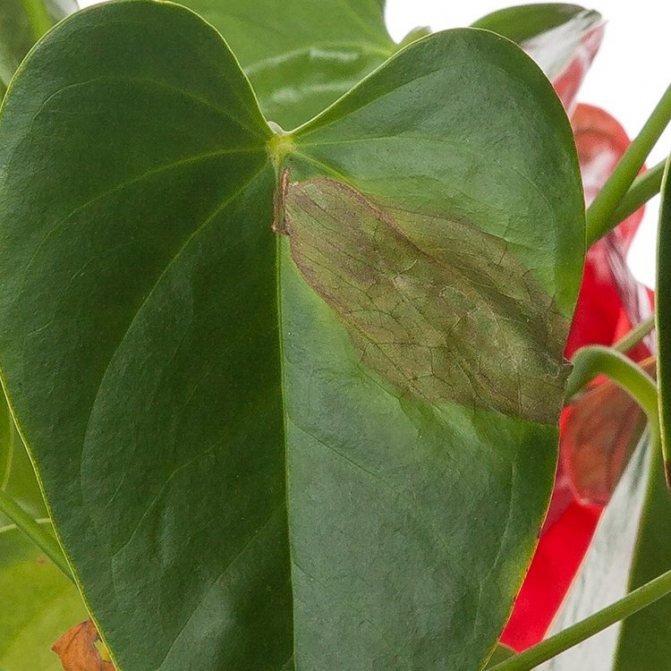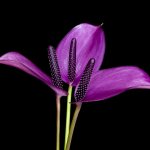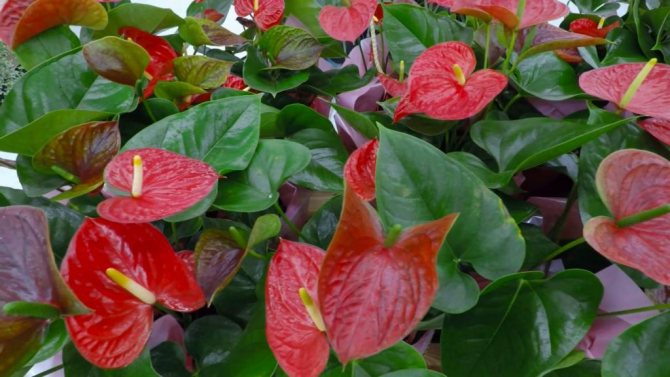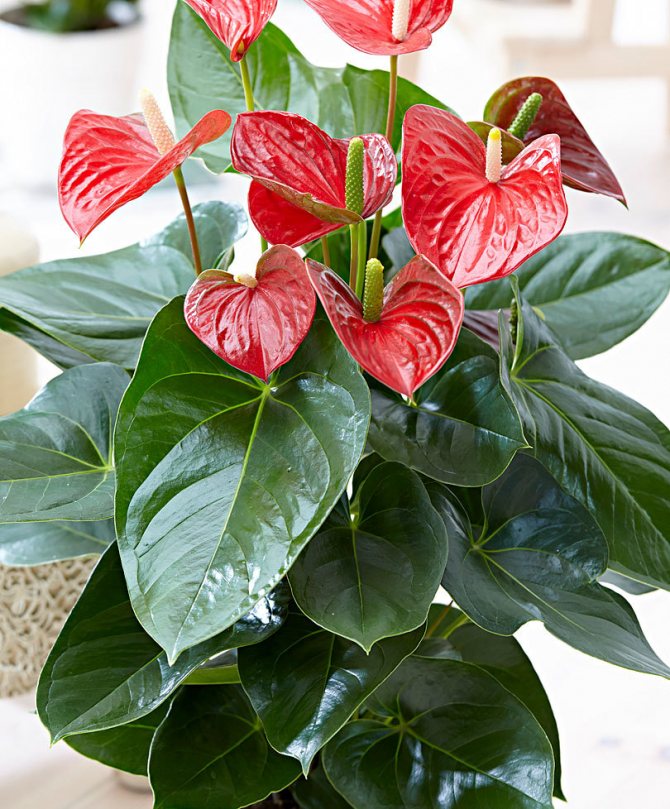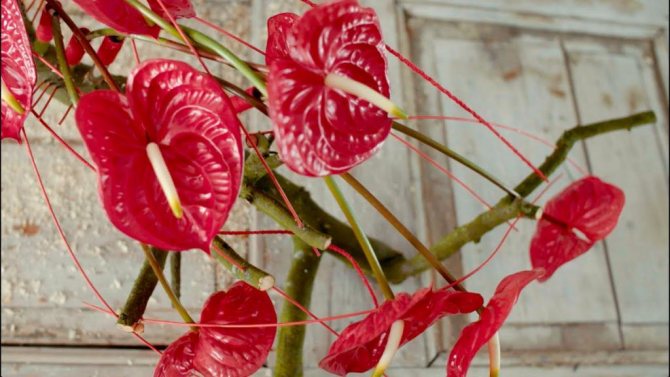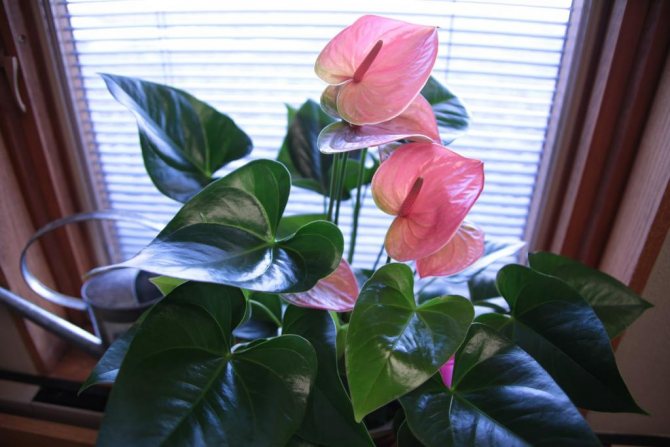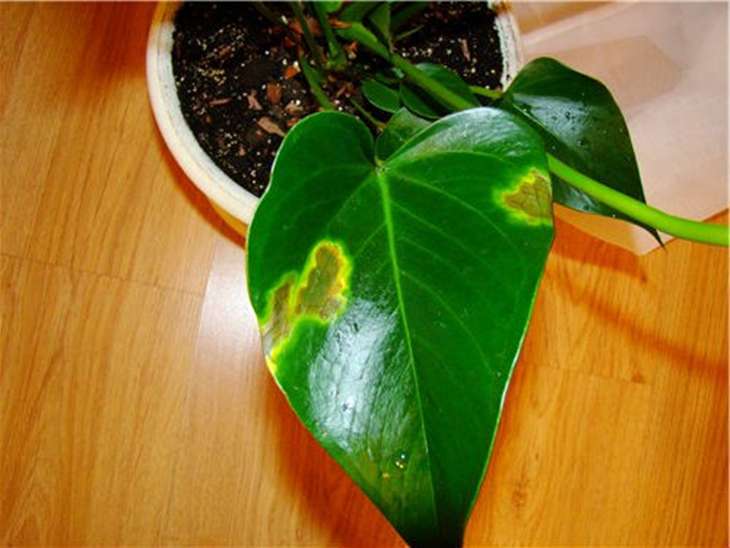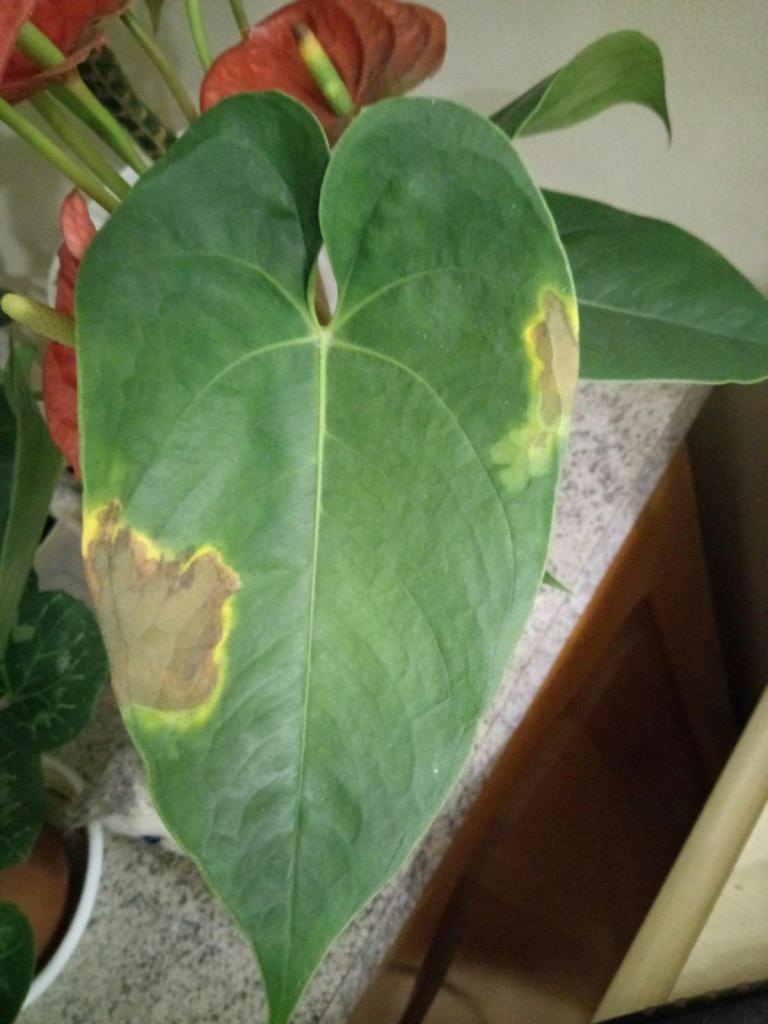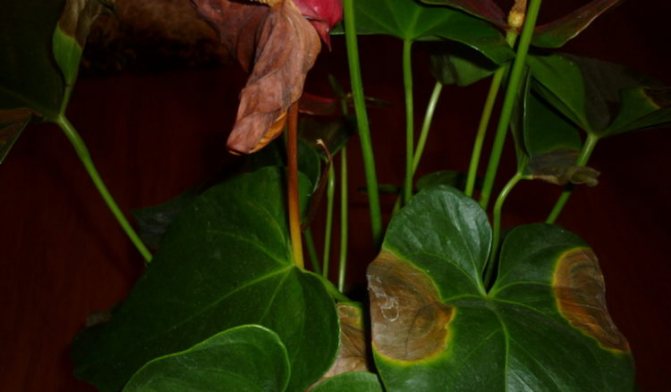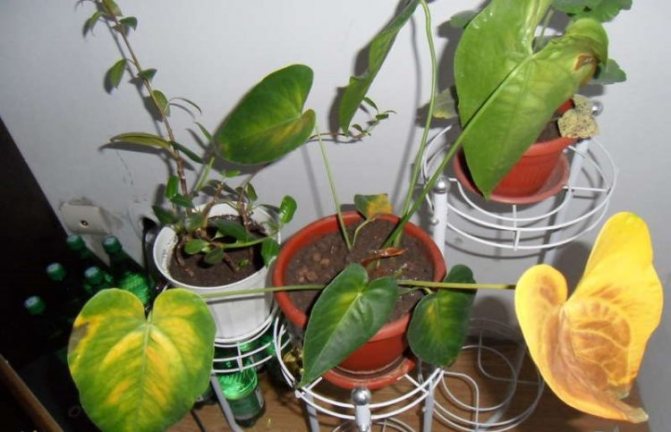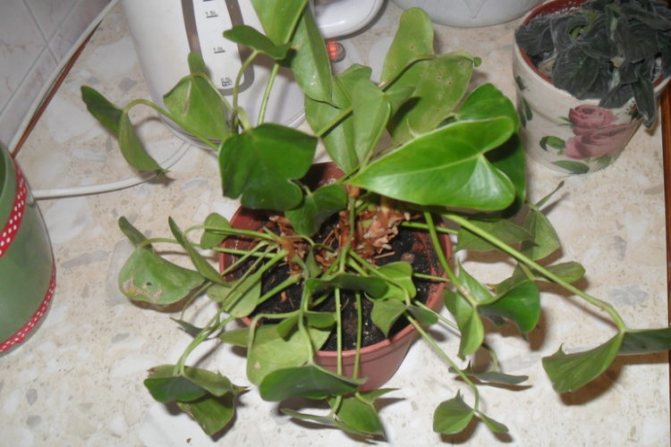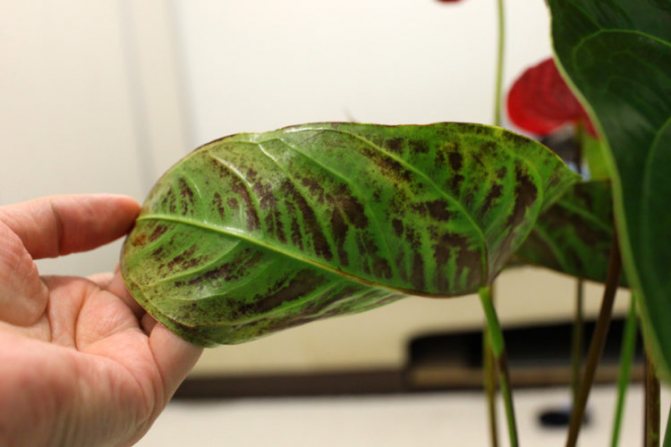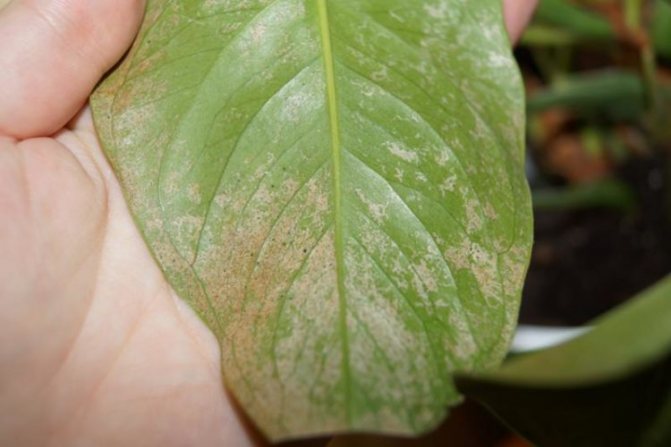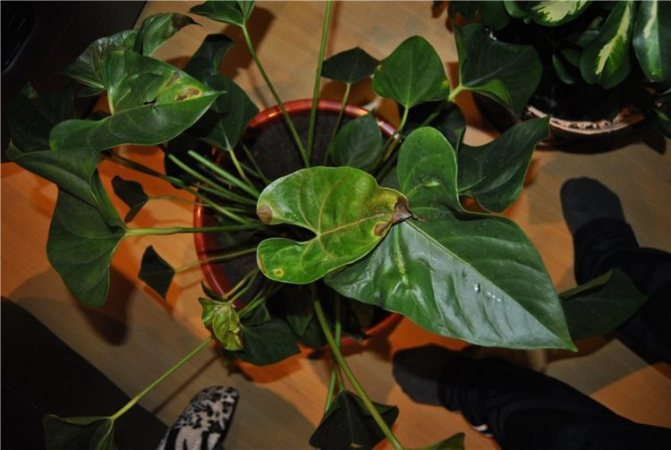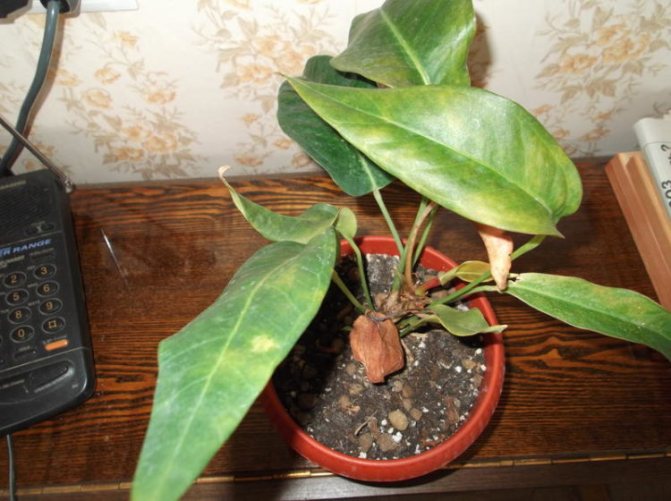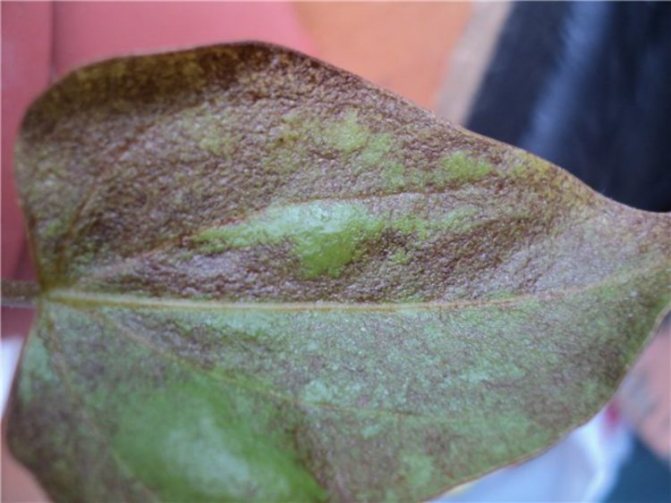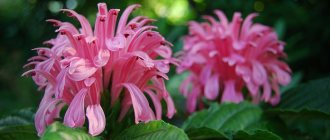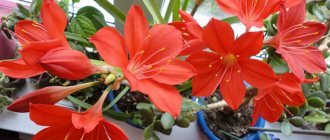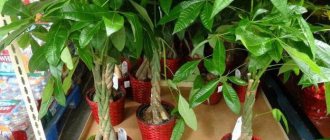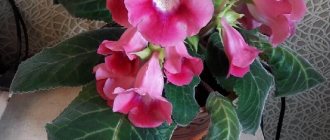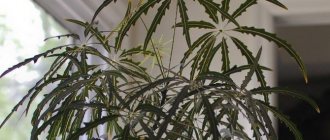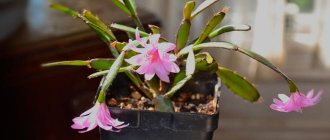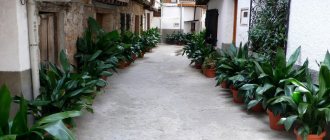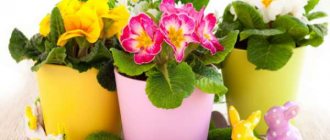Anthurium is a perennial plant of the Aroid family. Most often they lead an epiphytic way of life (they live on the bark of trees). Among them there are shrubby flowering and decorative deciduous plants, lianas. The name is made up of two ancient Greek words that translate as "flower" and "tail".
This is due to the type of inflorescence: an ear (similar to a tail), surrounded by a blanket of bright color (red, white, greenish, pink, burgundy). It blooms well even at home: in the summer there are 6-10 inflorescences on the bush, in the winter - 3-4 pcs. Male happiness is the popular name of the plant, since this colorful flower is often given to men.
The fruit is fleshy juicy berries containing seeds. The fruits should not be eaten. The rest of the plant is also poisonous - be careful when caring for the flower, keep children and animals away from it.
The natural habitat is the tropics of South America. Anthuriums were introduced to Europe in the 19th century, but gained wide popularity at the end of the last century.
Do I need to transplant anthurium after purchase?
After the purchase, it is better to keep Anthurium in quarantine for two weeks, and only then transplant. During this time, the plant adapts to the conditions of your apartment and will more easily tolerate a transplant. Why transplant, it becomes clear if you think that the seedlings are temporarily planted in peat, which, in principle, is not suitable for permanent maintenance. The plants were grown using special fertilizing, so in indoor conditions you need to provide the flower with good nutritious soil and a larger pot.
How to transplant anthurium after purchase, we look at the video:
For planting, use a substrate for epiphytes, a mixture for orchids is suitable. You can use light coniferous-leaf soil.
Soils and dressings
Why does anthurium have small flowers? Care plays an important role, and here the correct choice of substrate for planting and regular feeding should not be underestimated. The soil for the plant must be used loose and with good drainage. Potting mixes designed for orchids are well suited for anthurium. You can also use a soil made of deciduous soil, peat and sand with pieces of pine bark.
Top dressing is applied only during the period of intensive growth, that is, in winter and summer. Frequency - once every two weeks. You can use both mineral complexes (in the form of solutions) and organic fertilizers, such as chicken manure.
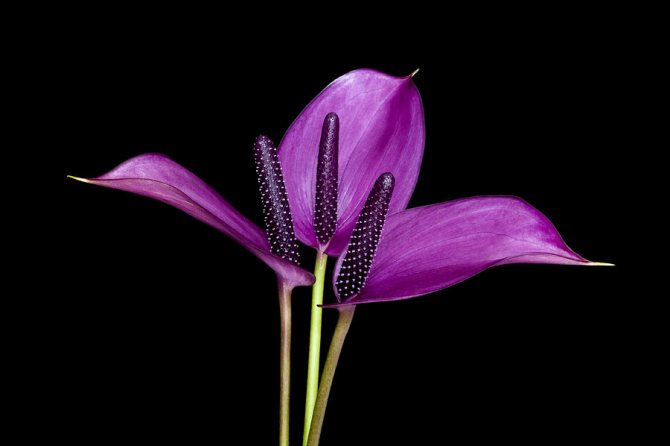
How to care for anthurium at home
Air temperature
The plant does not like sudden changes in temperature and drafts.
In the warm season, the temperature regime is 22-24 ° C, with the onset of cold weather, lower it to 15-17 ° C, a decrease in temperature at night has a beneficial effect on the plant's condition. When placed on a cold windowsill, you should protect the plant from hypothermia of the root system: put a layer of foam under the pot.
Lighting
- Lighting is required bright, diffused, shading is possible.
- The best place will be windows with an east or west orientation.
- Placed on the south side, shade out of direct sunlight.
- Under the influence of the sun, the soil quickly dries out, the leaf plates are covered with brown spots.
- If the lighting is insufficient, the petioles lengthen excessively, the leaves become pale, acquire a yellowish tint.
- Supplementary artificial lighting in the winter encourages flowering.
Watering, spraying and air humidity
Watering must be balanced: do not allow both the substrate to dry out and waterlogging. The latter is much more dangerous, since it leads to decay of the root system. The topsoil should dry out between waterings. Drain the water that has drained into the sump, especially if the room temperature is low.
In summer, as well as when wintering in a warm place with artificial lighting, you should water more abundantly.
Anthurium leaves are covered with dark brown or black spots when there is an excess of moisture in the soil or when watering with hard water. Therefore, for irrigation and spraying, use softened water (filtered, thawed or settled at least for a day), it should be warm.
It is important to maintain high humidity (75-85%).
Spray the leaves of the plant daily, but avoid getting water on the inflorescences. Also wipe dust off the sheet plates. Plants with matte textured leaves should not be sprayed.
Place the plant pot periodically on a pallet of damp gravel, expanded clay, moss or pebbles.
Anthurium in winter
With the onset of the heating season, the dryness of the air increases. Move the plant away from radiators and other heat sources first. Use special humidifiers. Place an aquarium next to the plant, any container of water.
Preventive treatments for diseases
Top dressing
The plant does not like an excess of fertilizers. Apply complex dressings for aroid or orchids in the spring and summer. Do this every 2-3 weeks, but at half concentration. You can fertilize with organic matter: mulch the soil surface with leaf humus.
If in winter you provide a dormant period (lower air temperature, minimal watering), you do not need to feed. When wintering in a warm place with additional lighting, leave the watering and feeding regime the same.
What should be the care for the plant to be healthy?
- A capricious tropical beauty does not tolerate too bright lighting - it is optimal to use diffused light or keep it in partial shade. In winter, the culture requires an additional source of light for flowering. A comfortable summer temperature for anthurium is 20-25 degrees, in winter it easily tolerates temperatures of 14-16 degrees.
- Drafts are very dangerous for the plant and can lead to its death.
- In the warm season, you need to water every three days, and in winter it is enough to moisten the soil once a week.
- It is very important to maintain high air humidity in the room.
- The leaves need regular spraying, but when water gets on the flowers, the inflorescences become stained and die.
- During the period of flowering and active growth, a tropical culture needs to be fed with mineral solutions or organic fertilizer.
Read also How to get rats out of the cellar
We suggest watching a video about caring for anthurium:
Most anthurium diseases can be avoided by following simple rules for caring for the plant. Even with a slight deviation from the comfortable conditions of keeping, the flower can overtake an ailment. This will be evidenced by any changes in the leaves of the flower.
If you find an error, please select a piece of text and press Ctrl + Enter.
How to choose a soil and take care of anthurium so as not to get sick, the video will tell:
The main condition for the full development and flowering of a plant is the correct choice of soil. Since anthurium is an epiphyte, one should take seriously its natural features, ensure good air and water permeability of the substrate.The availability of essential nutrients in the soil is also important. For more details, see the video.
Transfer
Inexperienced growers can come up with their own answer to the question of why anthurium has small flowers. Some of them think that this is due to an incorrect or untimely transplant. In fact, this is rarely true. Due to mistakes during transplantation, the plant may turn yellow, not pick up color, and even die. Whereas anthurium has small leaves and flowers most often for other reasons.
It is still necessary to transplant the plant: after purchase - after 10 days, young specimens - annually, mature plants - every three years.
Why do anthurium leaves turn yellow after transplanting
After a transplant, during which you divided the bush, or simply damaged the roots, the leaves of anthurium can turn yellow for a number of reasons:
- Damaged roots cannot provide the aboveground part with moisture and nutrients. It is necessary to cut off the yellowing leaves to facilitate survival, and water the plant with phytosporin to prevent diseases.
- Hard water is used for irrigation. It is necessary to water only with softened, settled water.
- During the transplant, the drainage was not laid, the water in the pot stagnates. It is necessary to transplant again, lay a drainage layer and use soil for epiphytes.
- Fed too early. The plant did not have time to recover, but it was already watered with a solution of mineral fertilizers. It is absolutely impossible to do this within 10-12 days after the transplant. Top dressing immediately after transplanting, if desired, is carried out only on the leaves!
Why do the leaves get sick and what to do?
If care and planting are violated, the leaves of anthurium can be affected by fungi and parasites. If cracked leaves, blotches of yellow spots, bumps, rot on the roots or falling leaves appear, then the rules of maintenance have been violated. Why, for example, do leaves crack for no apparent reason? Perhaps this is the case in the soil or in the water that is used to water the plants. To avoid infection, a diseased plant must be immediately isolated from a healthy one.
Diseases and pests of anthurium, care errors
Why did brown dry spots appear on anthurium?
If yellow-brown spots appear and grow on the anthurium, this is a sign of a fungal infection - septoria. An urgent resuscitation of the plant is needed: all the affected parts of the plant are cut off, and then the ground part of the flower and the ground are treated with a solution of copper sulfate.
Anthracnose is a disease in which the tips of the leaves of a plant dry out. It is necessary to remove the affected areas and treat the plant with Bordeaux liquid.
Pests
Possible pests: spider mites, scale insects, aphids. Pests and traces of their vital activity should be removed mechanically. Moisten a cotton pad or sponge with soapy water, wipe the sheet plates. Then apply an insecticide treatment.
Care errors
- Anthurium does not bloom - the pot is too spacious, so the anthurium builds up the root mass. It can also be triggered by excessive feeding or lack of a dormant period in winter.
- Anthurium roots rotted: what to do? Waterlogging of the soil can provoke rotting of the root system. At the same time, the leaves will turn yellow. It is necessary to carry out an emergency transplant, cutting off all affected parts of the roots. After transplanting, water the flower with a phytosporin solution.
- Leaves curl... There may be several reasons: draft, direct sunlight, low air humidity, insufficient lighting.
- Leaves are getting smaller from lack of nutrients or insufficient lighting.
- If the anthurium flowers are small - withered inflorescences should be regularly removed.
Houseplants Directory
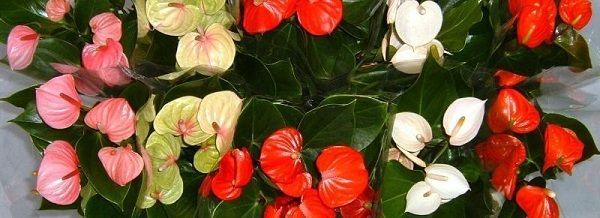

The genus anthurium contains up to 900 (according to some estimates, up to 1500) species and is deeply appreciated by lovers of indoor flowers of the Aroid family (this includes plants such as alocasia, philodendrons, monstera, syngoniums, scindapsus, zamiokulkas, dieffenbachia, aglaonema, spathiphyllum, anubias, colocastocoria etc.). All types of anthuriums are loved for their beautiful leathery, shiny, large leaves and unusual-shaped flowers that resemble sailboats.
Ornamental species are usually grown at home, including Hooker's anthurium, Veitch's anthurium, crystal anthurium, climbing anthurium, which is used for vertical gardening. The most popular are Andre's anthurium and Scherzer's anthurium, in which the inflorescence is characterized by a pronounced veil.
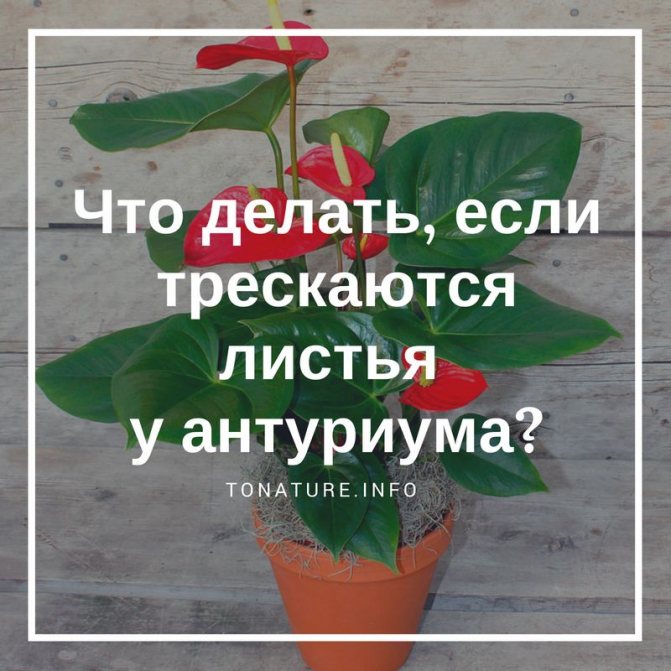

Anthurium is a wayward plant. To grow it and maintain a well-groomed appearance, it is necessary to use special soils, which will, moreover, be filled with substrates (they can be made at home on your own or purchased in specialized stores), have a drainage system, because this plant does not like being flooded or overdried , therefore, an optimal soil care system must be present. In nature, anthurium grows in loose soil with the remnants of rotted wood, which is constantly ventilated and is not oversaturated with moisture. However, at home, it is advised to use soil for orchids or violets (coal, peat, bark or sphagnum) with the addition of high-moor peat, perlite and leaf humus. Instead of high-moor peat, you can use store-bought, but not purchase low-lying soil, because it is completely unsuitable for growing anthuriums.
If the rules for choosing and caring for the soil are followed, the plants will delight you with their extraordinary beauty, otherwise, if the soil is oversaturated with water, improper care, and not following the appropriate criteria for room care and location, anthurium can "pick up" a viral disease, suffer from rot in roots, stems, parasite infestation. How to check if everything is in order with your anthurium? If you notice cracked leaves, blotches of yellow spots, bumps, white rot on the roots, yellowing, falling leaves, then the rules for keeping the plant have been violated.
If the leaves are cracking and there are no other visible and familiar reasons to judge the disease of the flower, then this is the case in the soil or in the water that is used to water the plants. The fact is that a certain type of soil may or may not be combined with the water you are using. Anthurium is especially harmful if you water it with tap water, since it contains heavy metals that irretrievably draw vitality from the soil.
Read also What is phytosporin for?
Various diseases are easy to identify: the roots acquire a putrid odor, the leaves change color to brown, begin to dry out, curl. To save the anthurium, it is necessary to transplant it into new soil, observing the rules of correct planting, water it with clean water, observe room parameters (light, humidity, temperature) to create an ideal territory for plant life. You can also treat leaves and roots with special solutions. For example, systemic solutions of a fungicide (Fundazol, Oksikhom, Ridomil-Gold). Remember, anthurium is a delicate plant that needs constant and careful care, the leaves of which should be carefully checked from time to time for parasites and diseases, the soil and roots should be kept in perfect condition and the plant should also feel your love and comfort in the house.
Please rate the material you have read :)
Overmoistening. Feeding anthuriums is done every 2 weeks with a half dose of fertilizer.
Save your flowers urgently.Aktara, Actellic. A real tick in your flowers! I also noticed it on Anthurium, then another on a flower, and another. I sprayed all the flowers three times (with an interval of 4-5 days) with Aktellik (better on the balcony, very smelly). Today I watered the flowers (through a pallet so that the entire earthy clod is saturated) with Aktara's solution. And also, remove all cracked sheets.
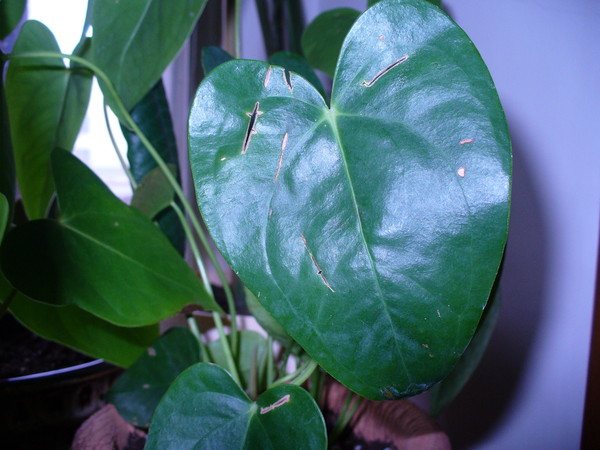

Most likely - damage to young growing leaves that have not yet unfolded. Try not to touch the young leaves, or check for pests. I would cut off the damaged leaves and treat the flower with Aktara for prevention, transplant it into normal soil, spray it with epin and look at the result.
Anthuriums love light, but cannot tolerate direct sunlight. From March to September, apply flower fertilizer in half concentration 1-2 times a month, alternating with a weak mullein solution. In some anthuriums, a dormant period begins from September, which lasts until February - provide moderate watering and a temperature of about 18 degrees. Anthurium is transplanted in the spring (usually every 2 years), when the ground is fully rooted. Florists prepare the substrate for anthurium from mixtures (optional):
- peat, turf, chopped moss, sand (4: 2: 1: 1);
- peat, leafy soil and sand (1: 1: 0, 5);
- leafy, coniferous land, peat, sand (2: 2: 2: 1).
Pieces of deciduous tree bark, rot, charcoal, broken brick, sphagnum are added to the substrate. The pot should be wide and well drained.
Reduce watering, in anthuriums it is from this that the leaves can crack.
stop spraying altogether, watering only after the earth dries out 2-3 cm deep into the pot, none of the anthurium died from drying out
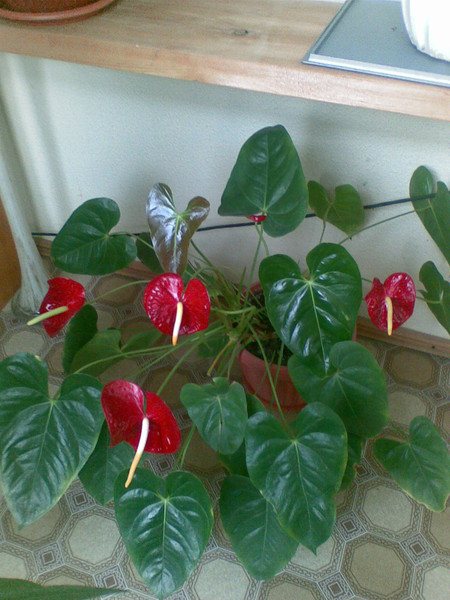

How to transplant anthurium
- Transplant in spring or summer.
- Transplant young plants annually, adults - as the roots are woven into the earthy coma (about once every 2-3 years).
- Transfer together with an earthen clod, without violating the integrity of the root system.
- If the roots are rotten, it is necessary to remove the affected areas, treat the cut sites with a fungicide.
- Increase the volume of the container by a few centimeters - anthurium grows better in cramped conditions.
- The most suitable container would be a plastic pot with large drainage holes.
Anthurium soil
Loose soil is required. Suitable substrate for orchids or coniferous-leafy soil. If possible, prepare the soil mixture yourself: 1 part each of leaf and coniferous soil, peat, 0.5 parts of sand, add a little bark, charcoal, perlite or sphagnum.
Be sure to place a drainage layer on the bottom of the container.
What to do in case of diseases of the root system?
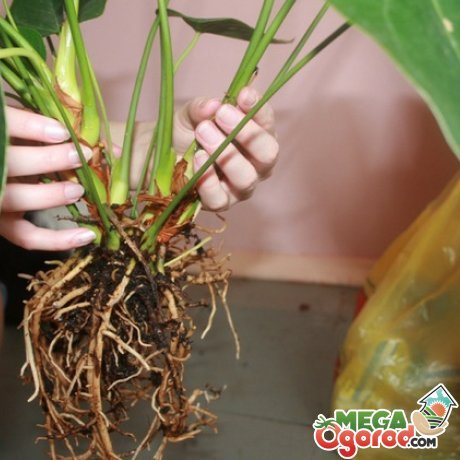

Very often, yellowing of the leaves signals the florist about problems in the root system of the anthurium. Excessive watering and hypothermia lead to the appearance of rot, the development of fungal and bacterial diseases.
If you suspect root rot, perform the following actions:
- the plant is pulled out of the pot and the earth is shaken off very carefully
- the roots are carefully examined
- rotted roots are removed to healthy tissue with a sharp knife, the sections are sprinkled with crushed activated carbon and dried
- the plant is transplanted into a new pot according to the size of the updated root system (i.e. smaller diameter than the previous one)
- adjust the conditions of keeping anthurium
In a situation where most of the leaves have turned yellow and disappeared, that is, with severe root damage, resuscitation measures are carried out:
- the affected leaves are removed
- the remaining leaves are treated with stimulating drugs (for example, Epin)
- the roots are cut to healthy tissue, treated with a fungicidal preparation, wrapped in moist sphagnum moss and placed in a transparent glass with drainage holes
- the plant is placed under a phytolamp in a mini-greenhouse with high humidity
- in the greenhouse, the plant is not watered, the shelter is removed daily for 15-20 minutes for airing
- if the roots have completely rotted, the stem can be placed in water with the addition of activated carbon
- after the roots grow back, anthurium is planted in a loose substrate for orchids
- when the plant gets stronger, it is transplanted into permanent soil
Growing anthurium from seeds
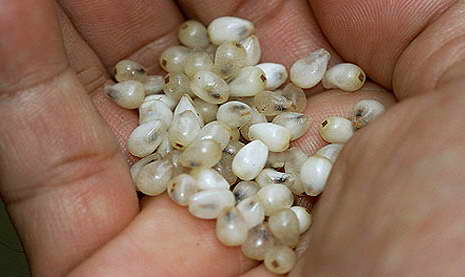

Anthurium berries photo
To collect seeds at home, cross-pollination is necessary. Ripening of berries with seeds takes about 10 months. Sow freshly harvested seeds immediately.
- Remove the seeds from the berries, soak for a few minutes in a solution of light pink potassium permanganate, rinse.
- Plant with a toothpick in a container with light, loose soil.
- Spread the seeds over the surface of the soil, sprinkle a little on top with soil, moisten with a spray bottle.
- Cover crops with glass or foil, keep the air temperature around 22-25 ° C.
- Air the greenhouse, moisten the soil.
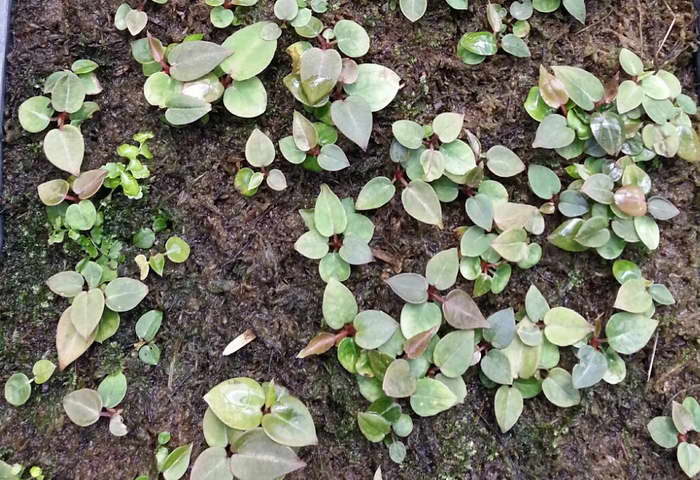

Anthurium from seeds photo of seedlings three weeks after sowing
- Seedlings will appear in a couple of weeks.
- When 2-3 leaves are formed, plant in separate pots with soil for mature plants.
- Full flowering occurs in the 5th year of the plant's life.
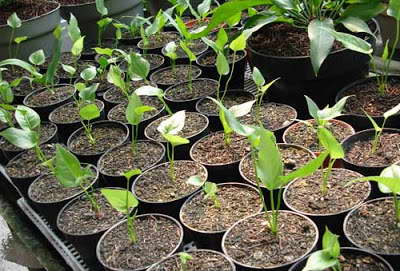

Anthurium from seeds photo of seedlings
Remember that variety differences are lost during seed propagation if the seeds are harvested from hybrid forms.
Diseases
The anthurium flower is a poisonous plant and therefore is not attacked by pests. However, the plant is susceptible to diseases due to which the leaves can dry out and turn yellow.
Gray rot
Very often, these indoor plants are affected by gray rot due to excess humidity in the room. Anthurium leaves turn yellow due to gray rot slowly, gradually becoming covered with a grayish bloom and spots. Subsequently, this disease leads to death.
At the first symptoms of the disease, it is necessary to sharply reduce watering and stop spraying. The use of fungicides will help get rid of the disease. But before processing, the plant must be transplanted into a new soil mixture. The infected flower is immediately isolated from other plants
.
If fungicide treatments do not help save the anthurium, then it will have to be destroyed.
Septoriasis
This disease is caused by fungi. Because of it, the leaves of anthurium are covered with yellow spots. In the initial stages of the development of the disease, the flower can be saved. yellow leaves are cut off, and healthy ones are sprayed with fungicides according to the instructions.
If you do not take any measures, then the yellow spots will grow, the foliage will gradually dry and fall off. Septoria can cause flower death.
Anthracosis
At home, these indoor flowers are often affected by anthracosis. Contaminated soil can become the source of the disease, since fungi multiply in the soil. A sign of anthracosis is whitish spots on the leaves. The foliage turns yellow at the edges. In the initial stages of the development of the disease, the flower can still be saved.
A diseased plant requires urgent transplantation into a new pot with clean soil. After transplanting, reduce watering and do not spray with water. All neighboring flowers should be treated with copper oxychloride for preventive purposes.
Chlorosis
Chlorosis is an infectious disease that can cause yellow leaves. The disease develops most often with a deficiency of magnesium and iron in the soil mixture. Typical symptoms:
- leaves turn yellow first;
- green veins appear on the leaf plates;
- the leaves dry and then fall off.
Chlorosis can be cured by feeding the plant with fertilizers, which contain iron, as well as algae.
Root rot
Often the causes of yellowing of leaves in anthuriums lie in diseases of the root system. The flower can be attacked by root rot. Anthurium can get sick due to an excess of moisture, cold water for irrigation and due to the low temperature in the room.
Root rot can only be cured by transplanting the flower into a new pot with fresh soil.
How to divide an anthurium bush during transplant
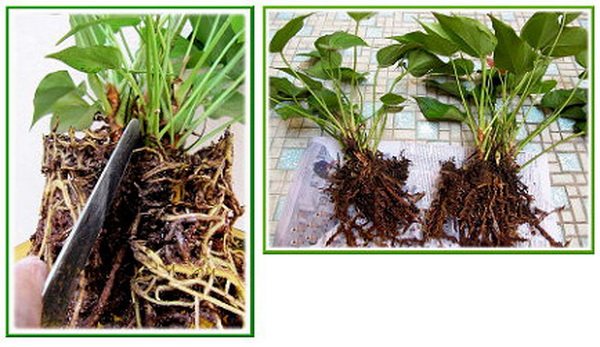

How to divide an anthurium bush during a photo transplant
Mature plants (at least 4 years old) can be divided at the time of transplanting.
- Each section should contain a part of the rhizome with growth buds and leaves.
- After dividing, treat the roots with a phytosporin solution (spray with a spray bottle and dry a little).
- Plant in separate containers as separate plants, remembering to provide drainage holes in the pot and a thick drainage layer of fine stone.
- After transplanting, also water the seedlings with a phytosporin solution to prevent various diseases.
Pests
Aphid
It mainly affects the most delicate green parts - apical buds, young leaves and shoots. The affected parts curl, sticky juice appears on them.
Important! You can bring aphids into the house with a bouquet of any flowers. Colonies of aphids are especially often observed on roses and chrysanthemums. Be careful when placing bouquets near houseplants.
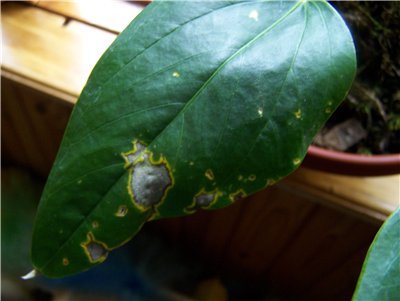

If there are few aphids, you can collect the pests by hand, and then treat the affected areas with soap suds. In a difficult situation, double treatment with a weekly interval with insecticides is used: decis, karbofos, arrivo.
Spider mite
The smallest pest sucks the juice from the cells of the green parts of the plant and multiplies quickly. Like other sucking pests, the mite can serve as a carrier of viral diseases.
More often the parasite appears in dry and hot conditions. The lesion manifests itself in the form of small white spots on the leaves, which then merge, the damaged parts dry out and crumble. Sometimes you can see the finest cobwebs.
Thrips
Small parasites are omnivorous and infect any plants. Colonies of thrips are concentrated along the veins of the plant on the lower side of the leaf.
With multiple attacks of pests, the leaves curl, turn yellow and fly around. Most thrips love hot and dry air. The treatment should be carried out with the same means as for the defeat of aphids.
Advice. To treat plants from the listed pests, you can prepare an effective folk remedy. To do this, 150 g of finely ground garlic is infused for 5 days in 1 liter of water, in a dark cool room. The resulting infusion is diluted at the rate of 5 g per 1 liter of water and the plant is sprayed in the morning.
How to propagate anthurium by cuttings
Most often, anthurium is propagated by lateral processes or cuttings.
- If the lateral process has no roots, it should be rooted in sand or perlite.
- Cover the cutting with a jar, glass, or plastic to create a humid environment.
- With the appearance of roots, transplant into a separate container. Root the apical cuttings in the same way.
- Cuttings take root perfectly even if you put them just in water - this method of rooting will be appreciated by "lazy" growers.
- After root formation, the cuttings are planted in pots like adult plants.
What if the anthurium turns yellow?
In a healthy plant, all foliage is flat, with a characteristic bright green color, without yellowness and spots. In addition, the leaves are renewed quickly.
, and those that appear again easily unfold without any damage.
But, if, nevertheless, a problem has formed, when the leaves of the anthurium turn yellow, what to do with the benefit of the flower - the advice of experienced florists will help.
When anthurium turns yellow for one of the reasons, below, you should do this:
What to do if anthurium has spots on the leaves?
The appearance of yellow spots on glossy
, dense leaves, a flower signals uncomfortable conditions for it or the development of any disease:
Anthurium is undoubtedly one of the most demanding plants for growing conditions. And if most of its leaves have turned yellow, lost, the florist needs to know how to save the anthurium
.
Flower resuscitation measures:
As soon as the anthurium grows new roots, it is planted in a special substrate for orchids. Later, the matured flower is transferred to a pot of soil.
In cases where the roots of the culture have completely rotted, the stem is placed in water with activated carbon. Perhaps your flower has not yet lost its vital energy. Then he can be saved.
Types and varieties of anthurium with photos and names
There are more than 900 plant species, some of them are cultivated with bred varieties.
Anthurium Andre Anthurium andraeanum
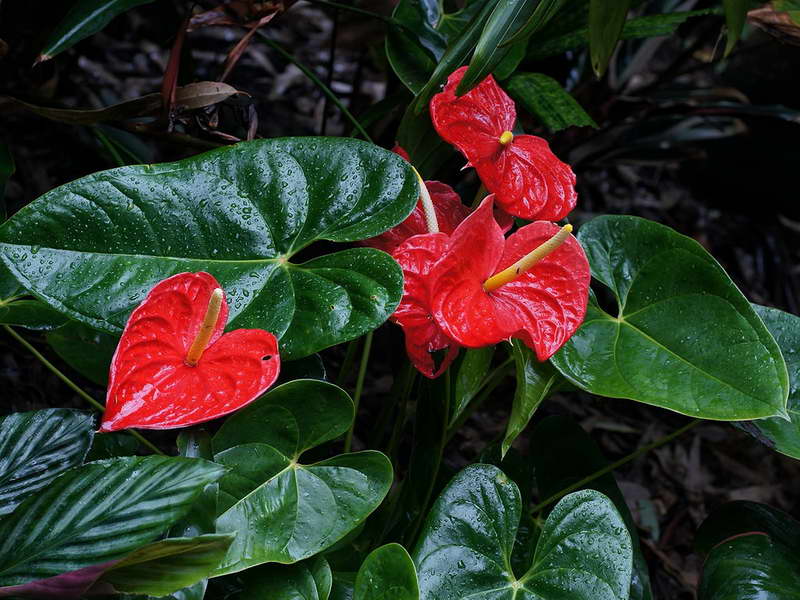

Anthurium Andre Anthurium andraeanum photo
Epiphytic plant with a shortened stem. On long petioles, heart-shaped leaf plates are attached, their length is 30-40 cm, width 15-20 cm. The cylindrical ear is stretched by 8-10 cm, has a white, yellowish, cream shade. A large bedspread (about 15 cm long) is painted in white, pinkish, salmon or crimson shades. The surface of the leaves and bedspreads is glossy.
Anthurium bakeri
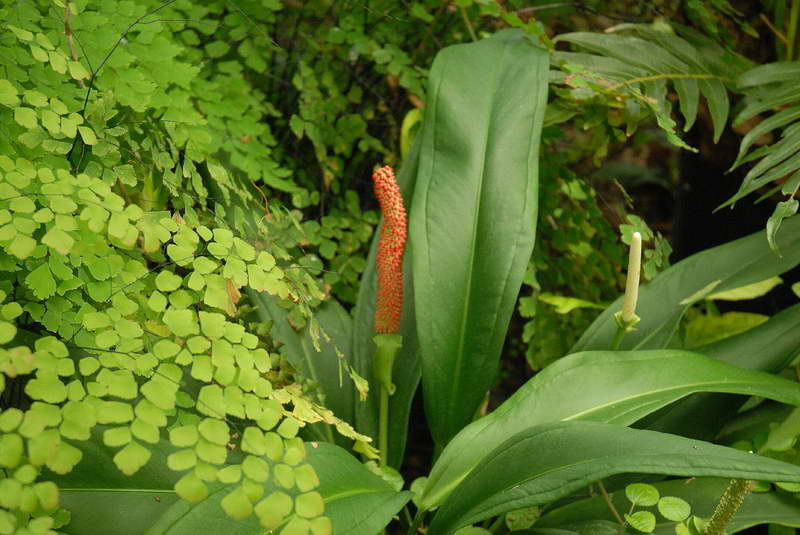

Anthurium bakeri photo
It has a short stem. The leaf plates are belt-like, dense, reach a length of 20-50 cm, the width is 3-9 cm. The surface of the leaf plate is green, the reverse side is decorated with brownish dots. The ear of a creamy white color is surrounded by a yellow-green veil with a lilac edging. The berries are colored red.
Crystal Anthurium Anthurium crystallinum
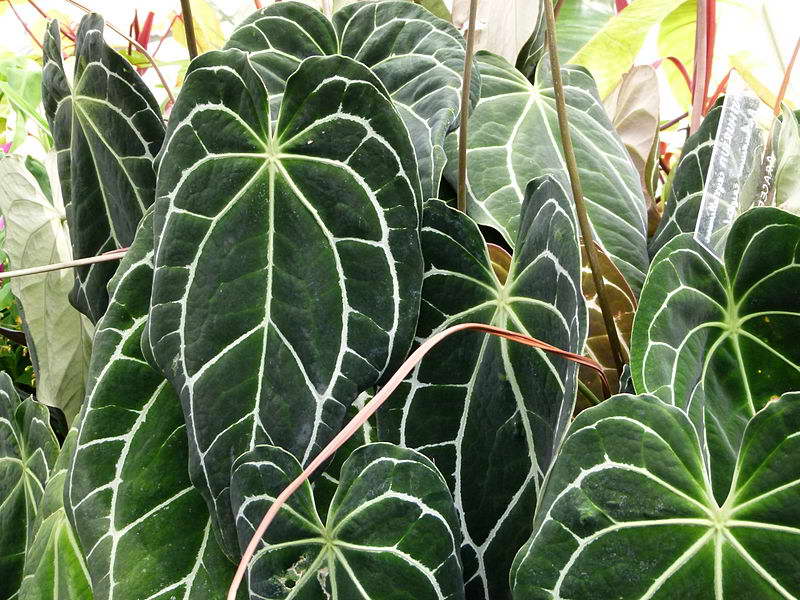

Crystal anthurium Anthurium crystallinum photo at home
An epiphytic plant with a caudex. Large leaf plates are attached to long petioles of a rounded cross section. They are painted in dark green with a purple tint, the veining pattern has a silvery tint. The ear is surrounded by a veil of light green with a purple tint.
Anthurium majestic Anthurium magnificum
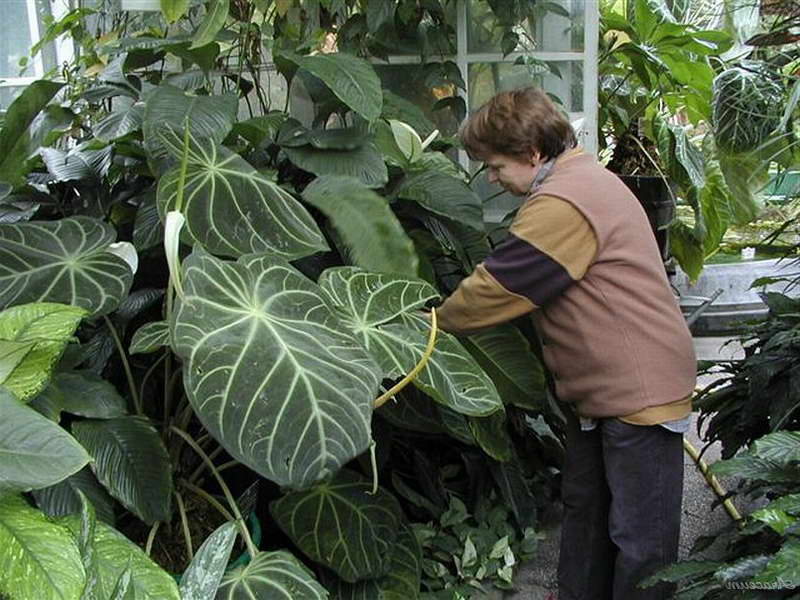

Anthurium majestic Anthurium magnificum photo
Similar to the previous view. Petioles are tetrahedral. The leaf plates are decorated with veins of olive shade.
Anthurium hookeri
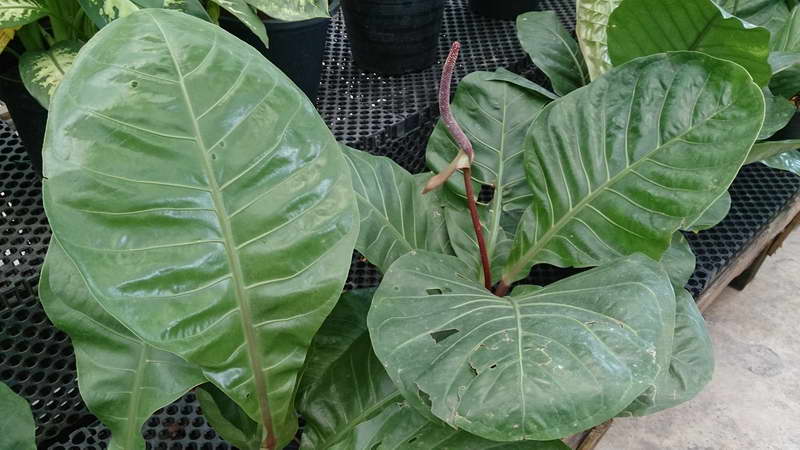

Anthurium Hookeri photo
Large leaf plates are attached on short petioles, they are oblong with pointed tops. The ear about 50 cm long is colored purple, the coverlet is greenish.
Anthurium climbing Anthurium scandens
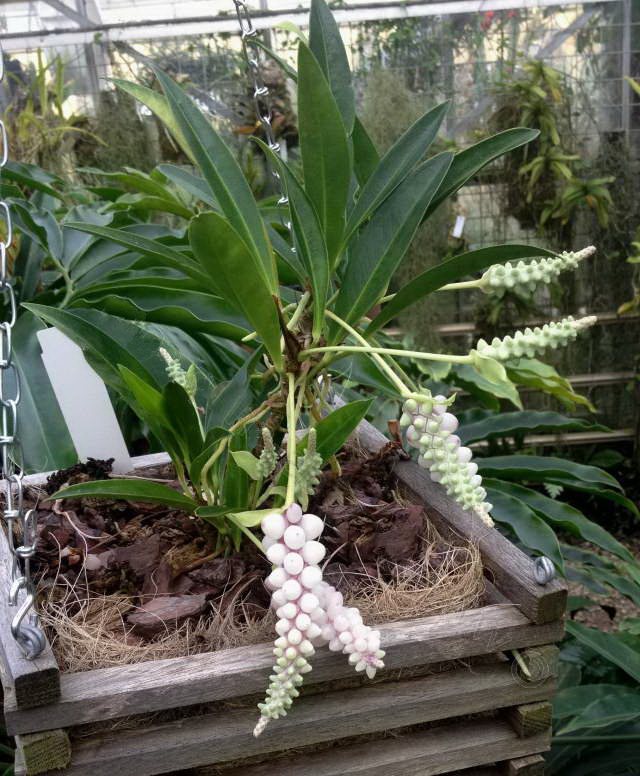

Anthurium climbing Anthurium scandens photo
It has a long curly stem, reaching a length of 1 m. The leaf plates are leathery, oblong. A small ear is surrounded by a greenish veil. Ripe berries look decorative: they are white or purple in color, covered with an oblong bracts of a greenish hue. At the same time, the plant contains flowers and berries.
Anthurium multi-dissected Anthurium polyschistum
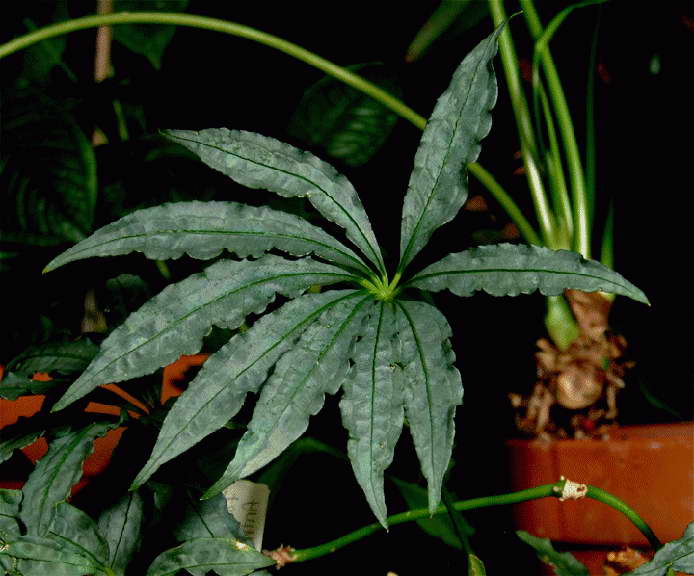

Anthurium multi-dissected Anthurium polyschistum photo
A small liana with finger-dissected leaf plates, the edges of the lobes are wavy.
Anthurium scherzerianum
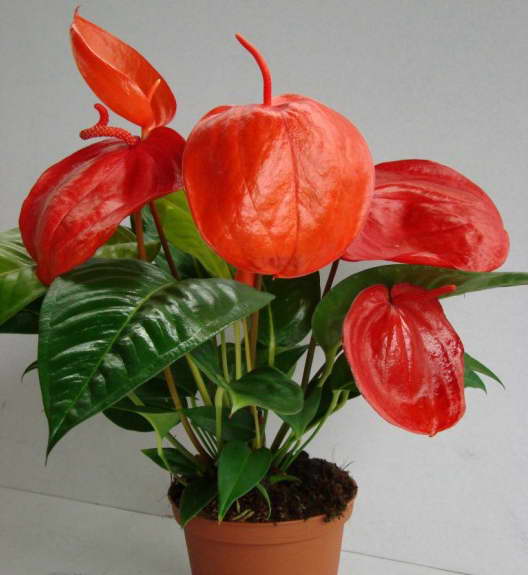

Scherzer's anthurium Anthurium scherzerianum photo
An epiphytic plant with elongated leathery leaf plates. The ear curls in a spiral, the bract has a red, pink, orange color.
Description of the plant
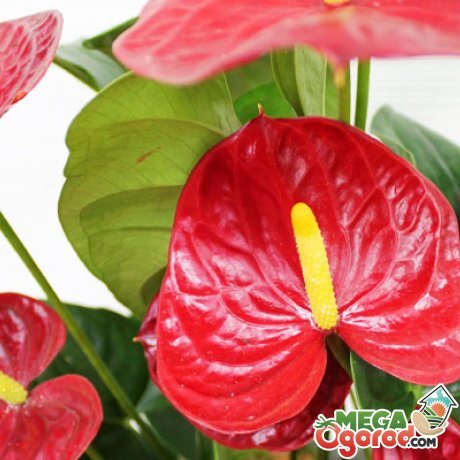

Anthurium is an evergreen plant that belongs to the Aroid family (Araceae). Comes from the rainforests of South and Central America. In nature, a flower can exist in different forms:
- epiphytes that live on trees and feed on aerial roots
- terrestrial
- lithophytes who have adapted to life on rocks, etc.
Anthurium has thick stems, short or elongated, depending on the type of plant. The leaves are usually leathery, matte or glossy. The shape of the leaves is varied: round, spatulate, heart-shaped. Inflorescence is an ear of small flowers, around which a so-called veil is wrapped. It can be in various shades of white, green, pink, red and even purple.
Because of this appearance, the plant is called "flamingo flower".
In room culture, there are both decorative leafy species (crystal anthuriums, Hooker, Veich) and flowering ones - these are the most popular among flower growers Andre's anthurium and Scherzer's anthurium.
The legend of anthurium and the energy of the plant
The legend about the origin of the flower appeared in his homeland - in Colombia.
One tribe had a cruel leader. He looked for a wife from a neighboring tribe, but was refused. Out of anger, the bloodthirsty ruler ordered to destroy the village in which she lived, and to bring the girl by force. In protest, she appeared in a red dress and threw herself into the fire. The gods turned her into a graceful flower.
It is believed that the plant brings prosperity and happiness to newlyweds. During the honeymoon, it is customary to put it in the room of the spouses.
Plant care
The air around the plant should be well humidified. It is required to spray it a lot and often, and sometimes wipe the foliage with a damp cloth. To strengthen and develop the growth of adventitious roots, you need to overlay the stems with moss. If you follow all the requirements, anthurium will bloom magnificently all summer.
In the spring and summer, the flower grows, it must be fed, fed every 15 days, alternating organic and mineral fertilizers. The flower is transplanted annually in the spring (if the base of the flower is more than 25 cm wide, transplant is carried out every six months).
There are many reasons why flowers can become pale and small. This can be both a consequence of improper care, and one of the signs of the disease. Before starting active actions, you need to find out the cause, and then effectively eliminate it.
Anthurium content in water
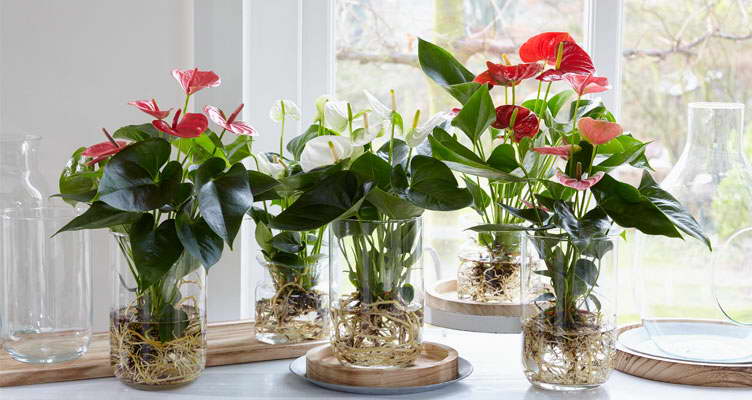

Anthurium in water in a glass vase photo
Anthurium looks very nice when kept in water. Flowers in transparent glass vases look fabulous. Such a trick can be performed during flowering, and then again plant the plants in the substrate. With this content, water is simply topped up as it is consumed, only distilled water is used, the plants are placed in a bright room, trying not to expose them to direct sunlight.
Correct care
The best prevention of the appearance of diseases is proper care and organization of proper conditions of detention.
Growing anthuriums at home is a very troublesome task, since the flower is quite capricious. The first sign that a plant is not feeling well is the appearance of yellowness on the leaves.
Watering
For anthurium, it is not so much the amount of irrigation and the volume of water that is very important, but its quality. Do not water the flower with tap water. Water for irrigation should be defended for at least a day. It is helpful to soften tap acid with citric acid. To do this, add a pinch of acid to a bucket of water. The best water for irrigation is rain or melt.
Many growers consider anthurium to be a capricious plant, for its successful growth and development, as well as for lush flowering, you will have to create a piece of the South American tropics in your apartment. If the conditions of detention are not observed, anthurium can get sick or be attacked by pests.
Draft and cold
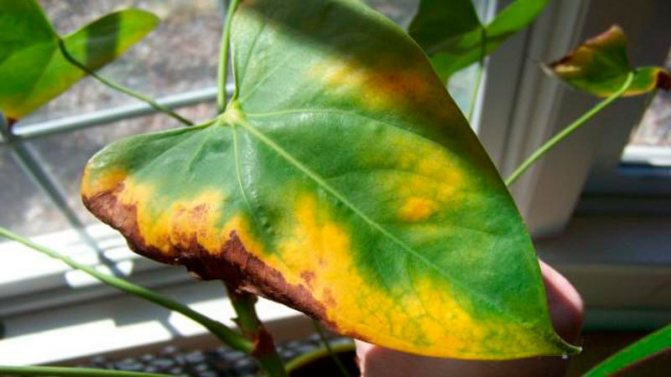

If the leaves of the anthurium are drying, what should I do (the photo shows an illustrative example of this problem) to save the plant? Florists answer: you cannot put a flower pot near the balcony door, which residents often open in winter. If you ignore this advice, it is highly likely that the leaves of the anthurium will dry out. To protect the plant from drafts and cold air, it must be removed from the room during airing.
If the leaves of the anthurium are slightly frozen, the plant can be restored. All damaged organs of the flower must be carefully cut off and placed in a warm room. The next step is to treat the plant with a growth biostimulant. However, the root may be damaged, therefore, in this case, you will have to transplant the anthurium, after cutting off the rotten areas. It is advisable to treat the cuts with cinnamon.
What to do to deal with the problem?
If the rules of care are followed, but the plant is sick, urgent measures need to be taken, keep this in mind if necessary.
First, do not panic, but take a close look at the flower. Secondly, eliminate all violations. Third, take all measures to save your beloved flower. With chlorosis, feeding with algae extracts or iron chelates will help.
Gray rot affects anthuriums in humid rooms. Eliminate the cause of high humidity, do not spray the leaves too often - and everything will return to normal.
If the plant is infected with rust, remove the damaged leaves, wash the rest with soapy water.
Fusarium is one of the most dangerous plant diseases, as it can also infest your other flowers. The causative agent of fusarium is a fungus, so special preparations (fungicides) will help.
Fungal diseases of septoria and anthracnose are no less dangerous. Start spraying anthurium with fungicides immediately so that you don't lose this and other plants. Repeat the treatment after 2 weeks.
Note! Peat and sandy soil have a beneficial effect on the growth of anthurium, but these flowers do not like alkali. The plant needs a transplant once a year for young flowers, adults are transplanted once every 3-4 years.
The roots of anthurium, having completely filled the volume of the pot, begin to emerge from the drainage holes - this is a signal that a transplant is needed.
You can feed anthurium with weak extracts of organic fertilizers. But organic matter and mineral fertilizers are needed no more than 1 time in 14 days during growth.
What does anthurium look like: photo
In the photo in our gallery you can see what this flower looks like. He's very handsome, belongs to evergreens
... Anthurium comes from the tropics, and its flowers have a special bizarre shape, which is why it is often called the flamingo flower.
Anthurium is very popular among amateur and professional flower growers. It looks unusual in itself, and it can also be used in different ways in different flower arrangements and bouquets. If you wish, you can find a photo of examples of such combinations.
Another feature of the plant is the ability to stand cut in a vase for several weeks in a row.
However, there are a number of anthurium diseases that affect the leaves of the plant. They give owners a lot of trouble. Most growers believe that they are better prevented than treated.
What to do, how to avoid the problem?
It is possible to avoid the problems associated with yellowing of the deciduous mass only with proper crop care. Having found a loss of decorativeness, reconsider the watering regime, pay attention to the temperature and humidity of the air, the level of illumination. Make sure to select the correct substrate and capacity.
Check the sheet from the underside for pests. Do not neglect or overuse feeding. If necessary, carefully remove the bush from the pot and inspect the root lobe.
On a note! Only a comprehensive close examination will help to make a conclusion about the violation of agricultural technology. The florist will only have to eliminate his own mistakes.
Fungal disease on anthurium
If the room is cool and watering is disturbed, there is a high risk of fungal disease. When the fungi begin to work, dry spots appear on the leaves. First, small yellow spots of irregular or round shape appear, then they begin to expand, and the center becomes brown and begins to dry.
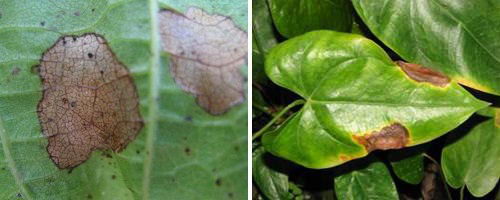

Damaged areas may begin to crumble and dark circles form around. But when the fungi attack, not only the foliage suffers - the roots begin to rot. Therefore, it is imperative to pull out the plant and check its roots, cutting off all rotten areas. Healthy roots should be light cream or white in color. If they turned brown or black, soft spots appeared, possibly with areas of mucus - this is rot.
After cutting off the rotten roots, the cut sites are treated with crushed coal, and the anthurium itself is treated with a fungicide.In this case, before processing, it is necessary to remove all leaves damaged by the fungus.
The pot needs to be disinfected and filled with fresh substrate.
Possible reasons
To begin with, we note that yellowing and falling leaves are not always indicative of improper flower care. The fact is that this flower has a natural feature to shed old leaves and shoots growing from below - this is necessary so that the flower can build up strength for the appearance of young leaves. However, in most cases, the reasons are still related. in violation of the rules for growing this unusual flower.
If yellowness has arisen at the very edges of the leaf plates, then this is clear evidence of the defeat of the roots by various rot, this often happens with excessive watering of the flower and waterlogging of the soil.
If yellow spots appear on the lower tier, then most likely the plant has received too many nutrients which led to a chemical burn of the roots.
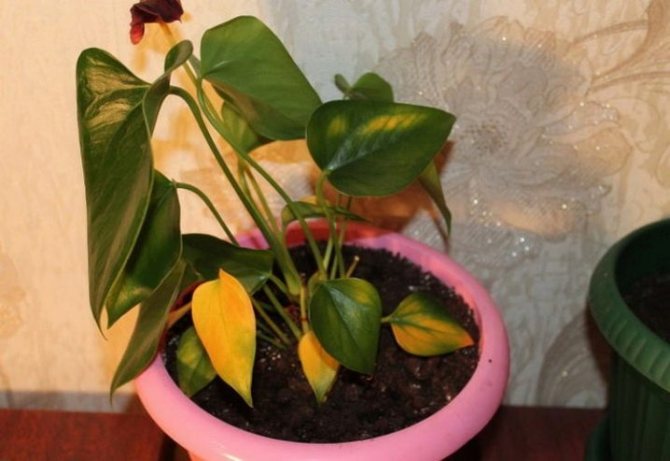

The tips of the leaves can also turn yellow due to too cold indoor air. As you know, anthurium reacts very negatively to drafts, they are especially dangerous in the cold season.
By the way, if you water the anthurium with too cold water, this also causes a change in the color of the leaf plates. The roots of this exotic plant are very delicate and cannot tolerate even the slightest violation of the optimal temperature regime.
If the yellowing of the leaves is accompanied by the appearance of holes, then this most often indicates an attack by pests. They begin to feed on the green parts of the plant, cutting through small holes around which the leaves begin to turn yellow. And also holes can appear as a result of fungal pathology - in this case, a yellow spot first forms, then the tissues inside it dry up and begin to die, forming a hole visible to the eye.
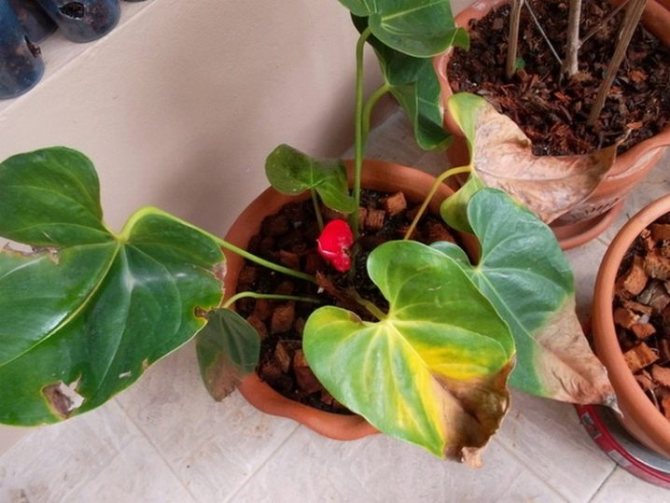

Diseases and pests
If diseases or insects are the cause of the yellowing of the leaves, the effectiveness of the treatment will largely depend on how quickly you were able to diagnose. In the early stages of damage, the flower can most often be saved, and as the disease spreads, the chances of reviving your green pet are rapidly reduced.
The most common diseases causing leaf discoloration are:
- septoria - occurs in conditions of high humidity, low temperatures and frequent drafts;
- rot - become the result of excessive watering and high humidity in the room;
- fusarium - such an ailment often happens to plants when changing the soil mixture, if it was compiled independently without preliminary disinfection;
- chlorosis - occurs in conditions of a lack of magnesium and iron in the substrate.
If one of the described diseases is found, it is necessary to cut off all the damaged leaves, transplant the flower into new soil and treat it with a fungicide solution. If the plant is severely affected, then it needs to be urgently reanimated - measures to save the flower will be discussed later.
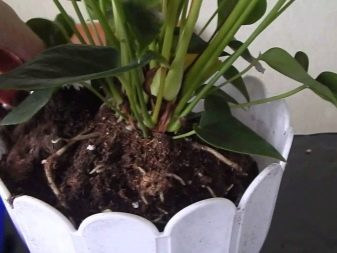

Care errors
Anthurium, as a real tropical culture, loves a humid warm microclimate, as well as diffused lighting. With any deviation from the comfortable conditions for him, the flower immediately disappears. The first signal of unfavorable processes is yellowing of the leaves.
Preventive measures
To avoid yellowing of the leaves, you must adhere to the rules for caring for a houseplant.
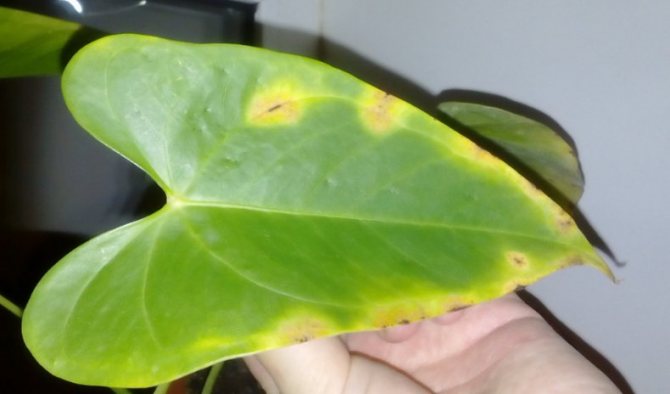

To prevent this phenomenon, you should:
- fertilize the soil on average once a month;
- keep the soil slightly moist;
- periodically rinse the plant from the shower;
- spray aerial roots.
The main problems when growing a flower
As we already said, anthurium is considered a rather capricious plant. This flower is used to tropical climates, so it does not always feel comfortable at home. Let's take a look at the most common problems next.
Lack of flowering
Many growers complain about the lack of flowers in anthurium. The reason for this behavior of the culture can be:
- Insufficient lighting. For a plant, both lack and excess of sunlight or artificial lighting can be detrimental. To solve the problem in preparation for flowering, you need to install an additional light bulb or other light source;
- Low air temperature. Solution: heat up the room to 22 degrees Celsius in summer and 14-16 degrees in winter;
- The lack of inflorescences is often associated with improper irrigation or insufficiently humidified air. Excess moisture is harmful to the culture, so the water must be taken in by the drainage layer;
- Another reason, dry inflorescences. After flowering, seeds begin to form on the crop. They take nutrients from the anthurium. You can solve the problem by cutting off dried inflorescences.
Anthurium leaves turn yellow
The main reason for the appearance of yellow leaves in anthurium is improper watering or the use of low-quality water with a large mass fraction of chlorine, as well as heavy metal oxides. To prevent this, you need to water the culture in moderation, the excess water should be absorbed by the drainage layer. The ideal option would be to use rain, melt or settled liquid.
Yellowness on the leaves of anthurium often appears through intense streams of sunlight or lack of lighting. In the summer, the plant needs to be shaded, and in the winter it should be left on a sunny windowsill. In some cases, it is necessary to transplant the crop into a new container or destroy pests.
Drying leaves of anthurium
Dry air in the apartment or drafts when the plant is located near an open window are considered the reasons for this adverse phenomenon. To solve the problem, you need to rearrange the flower away from the window, and periodically spray its leaves. During spraying, make sure that water droplets do not fall on the inflorescences.
Black spots on the leaves of anthurium
Blackening of the leaves in the culture under consideration indicates an excess of potassium in the substrate. In this situation, it is recommended to transplant the flower into new soil, for example, special soil for orchids, or apply organic and mineral fertilizers in the required quantities.
The tips of the leaves of the anthurium dry out
The main reason for this behavior of the flower is considered to be dry air in the apartment. You can save the situation by spraying the leaves of the crop. In winter, the pot with the plant is installed away from the radiators, and a container with water is installed in the neighborhood. Another reason for the drying out of the tips of the leaves is the lack of oxygen, which enters the roots. To prevent this negative phenomenon, the flower is transplanted or soil is added to the pot. To improve aeration, large impurities are added to the soil, for example, charcoal or broken brick.
Anthurium leaves in brown spots
In the first case, you need to select balanced fertilizers for the crop. Pests are destroyed with Karbofos or other chemicals.
Small flowers near anthurium
Experts believe that the reduction in the size of inflorescences and leaves of the culture in question occurs through natural aging processes. Over time, the trunk of the plant becomes bare, the lower leaves die off, the inflorescences do not appear at all or become small.
To solve this problem, it is necessary to rejuvenate the bush. The plant is pruned so that two or three aerial roots remain on its trunk. Next, the culture is transplanted into a new pot, the root system is treated with a growth stimulator. During further care, it is necessary to maintain a constant temperature in the room within 20 degrees, and also spray the plant with warm water.
As practice shows, anthurium is a complex plant for home cultivation.It is demanding in terms of temperature and humidity conditions. For him, temperature drops, drafts, waterlogging and overdrying of the soil are destructive. Having received the wrong care, anthurium gets sick. Diseases of leaves and roots make themselves felt immediately. So, anthurium is a disease of leaves and roots with photos and descriptions from specialists.
Helpful care tips
Here are some useful tips that will come in handy when growing anthurium:
- To stimulate flowering and plant new buds, it is recommended to water the bushes with heated water (40–45 ° C).
- It is contraindicated to add lime, chalk or wood ash to the substrate.
- Softeners can be added to the watering and spraying water as this plant prefers an acidic environment.
- Anthurium is a poisonous plant, so it must be kept away from children and animals.
- Strong drying of the earth in the flowerpot should not be allowed - this is destructive for the culture.
- Avoid repotting the flower frequently.
- For the health of anthurium, it is necessary to remove dust from its decorative leaves in a timely manner using a damp sponge.
- It is unacceptable for drops of water to get on the bracts and ears, otherwise they may turn black.
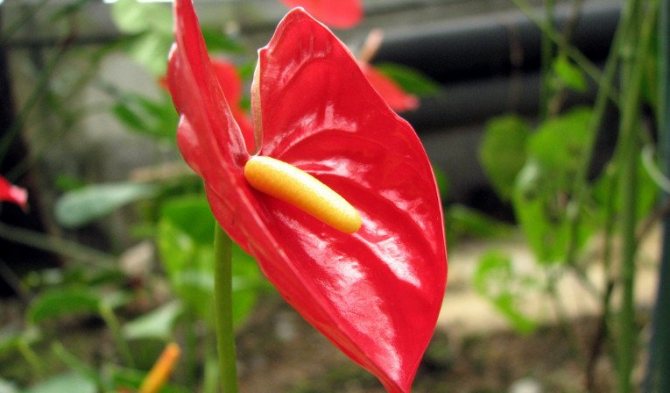

Summing up, we note that it is not at all difficult to grow a beautiful and healthy anthurium. If you pay enough attention to it, organize timely and competent care, as well as identify ailments and pests in time, you can avoid the above problems and decorate your interior with an exotic plant with spectacular and bright flowers for a long time.
What should be done to avoid the danger?
To save a tropical plant, you need to remove all infected and wilted leaves and treat the anthurium with a fungicidal solution. This should be done several times with a break of 15 days. You should also avoid hypothermia, frequent watering, and excess fertilization, as this can lead to bacterial diseases. So that anthurium diseases no longer disturb, you need to transplant a flower into new and fresh soil. For the safety of home flowers, you need to pay attention and competently take care of it, study its features. So that in the future there are no problems and yellow spots do not appear
Prevention of diseases of a spectacular indoor flower
Are the tips of the leaves dry on the anthurium? Why is this happening and what should be done?
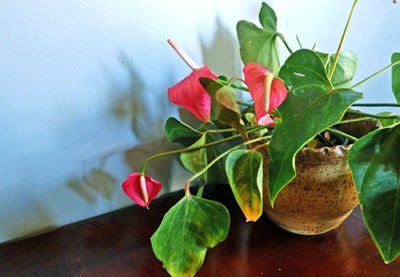

The process of yellowing and drying of the leaf in anthurium is inevitable - this is how the plant gets rid of old and unnecessary processes. At the same time, new leaf plates appear.
But what if the tips began to dry en masse, even in young leaves? What could be the reason?
What pests can attack this flower? What to do to combat them? You will learn about this in this article.
How to treat a plant?
Any change in pigmentation on the leaves in most cases indicates the presence of some kind of disease or uncomfortable living conditions for this flower.
Actions to save the anthurium directly depend on the reason that caused it to wither. Let's consider the main ones.
- Excess moisture. In this situation, it is necessary to change the irrigation regime of the anthurium as soon as possible. Irrigation should be fairly moderate but regular. For irrigation, you should use only soft water (filtered, thawed or settled) - tap water contains chlorine and metal impurities, therefore it is destructive for a flower.
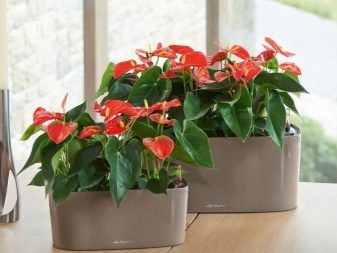

- Lack of lighting. Place the plant on the east and west windowsills. In the winter season, be sure to use additional illumination - for this, special phytolamps with a yellow lighting spectrum are used, however, ordinary fluorescent lamps will do.
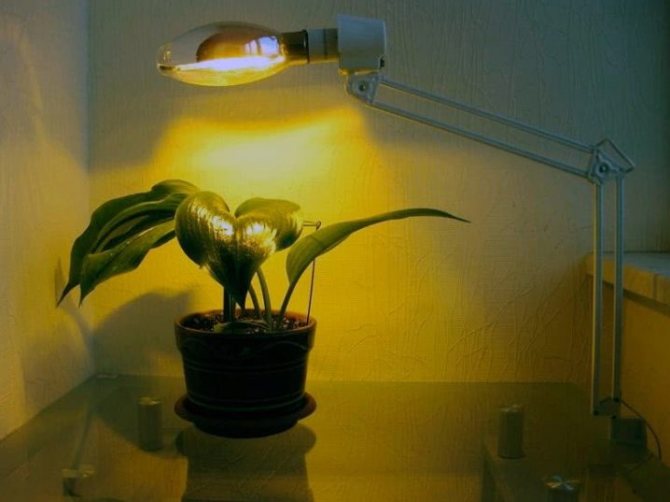

- Lack of substrate. Transplant the flower into a larger pot so that the container is replenished with potting soil.
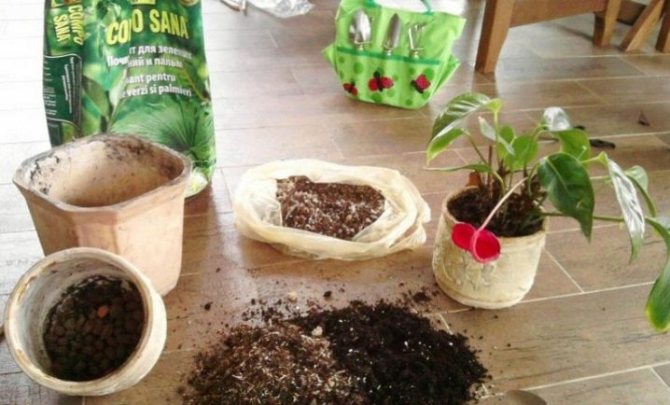

- Insect pest attack. Aphids and mealybugs are especially dangerous for this flower.To get rid of them, it is necessary to wash off all parasites with a solution of laundry soap, then treat the green parts of the plant and the surface of the earth with a special insecticide.
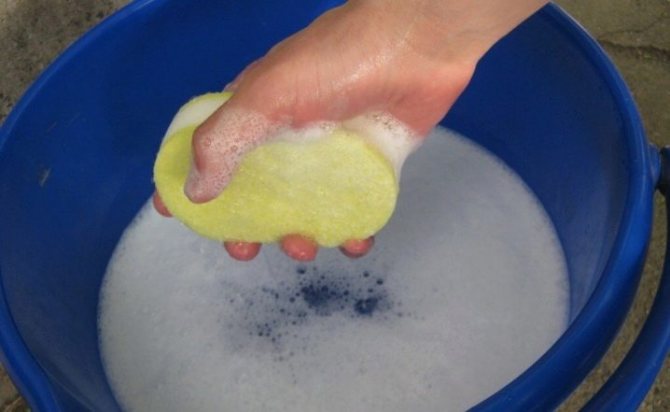

- Hypothermia. In spring, anthurium is often taken out onto the balcony, but one should not forget that at night the air temperature is quite low, and the plant can freeze very much. In this case, yellow spots immediately appear on its foliage, and it dies. In the same way, the plant reacts to the ventilation of the room, if in winter vents and windows are opened for this.
It is important not to create conditions in which anthurium can “get cold”.
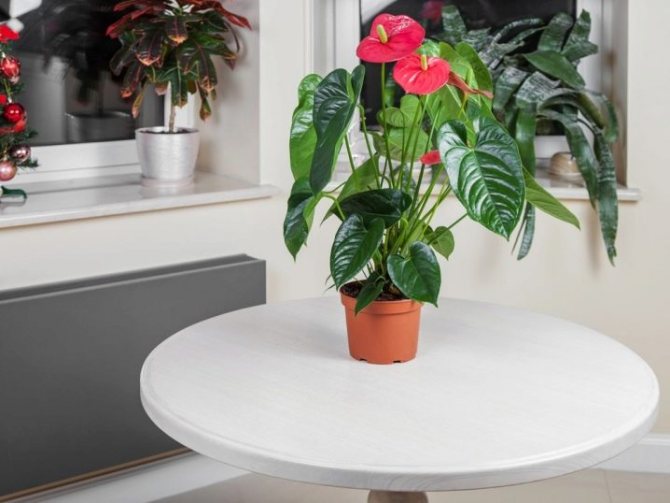

- Exposure to direct sunlight. This happens if the plant is placed on the south window. It is better to use other directions for this. But if this is not possible, then try to darken the flower - for example, use a small screen or stick a protective reflective film on the glass. Better yet, move it to a planter, flower stand, or desk near the window.
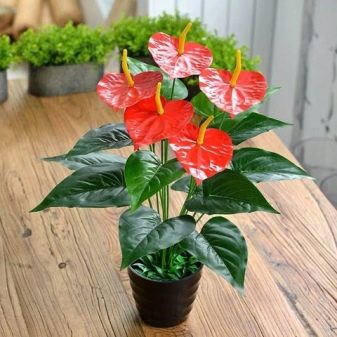

- Fungal infection. In this case, you need to start resuscitation as early as possible. To do this, remove all damaged leaves, transplant the flower and treat with a suitable fungicidal solution.
The treatment is repeated several times every two weeks. If the plant is more than 2/3 infected, it cannot be cured.
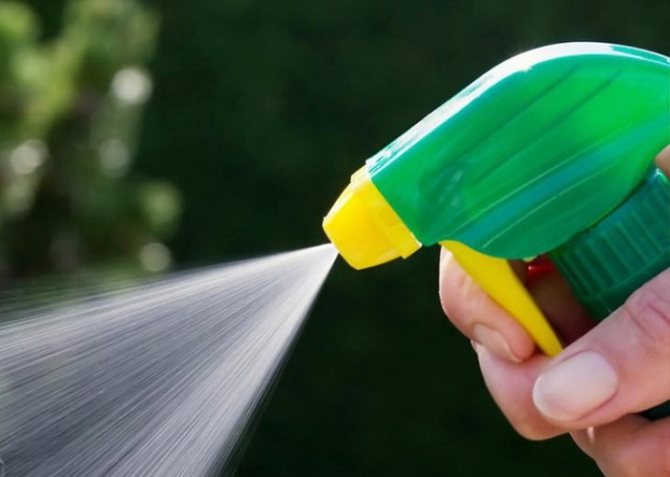

Poor growth factors
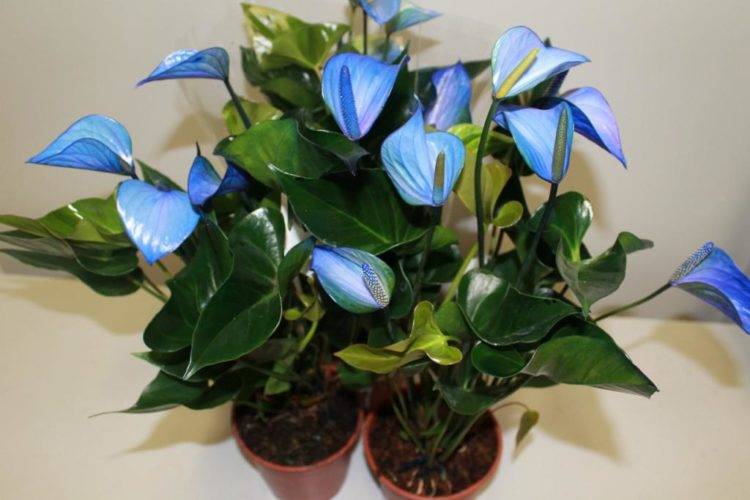

Why does the indoor flower not grow, despite the care? Possible problems:
- Dry air. In winter, it is better to rearrange the tropical inhabitant away from the batteries. They dry the air too much, to which this flower is not used.
- In winter, the decorative inhabitant accumulates strength, and growth stops until the warmer season. Frequent spraying with warm water will help him. Watering should be reduced to avoid rotting of the root system.
- A tropical inhabitant is cramped in a flowerpot.
- Insufficient nutrients.
A capricious anthurium can be successfully grown in an apartment, giving it due attention. It is better to solve all problems immediately, as soon as their first signs were found, then the flower will delight the owners for more than one season.
Natural aging
There is another option why anthurium has small flowers. The reason is natural aging and gradual degeneration of an adult plant. It is interesting that mature specimens look different from different growers. For some, it will be a lush and green bush with crushed inflorescences, for others, the number of flowers will decrease to 1-2.
But the overall picture will not be very happy. Anthurium will lose its exotic appearance, turn pale, its stem will be bare. In the future, it will simply stop blooming.
In this case, the plant needs to be healed and rejuvenated. The operation consists in removing the ground part so that a pair of aerial roots remain on the cutting. At the same time, the plant is transplanted and a little growth stimulant is added for good rooting.
Young shoots must be kept at a temperature of + 20-22⁰ and regularly sprayed with warm water.
Because of what the leaves turn yellow
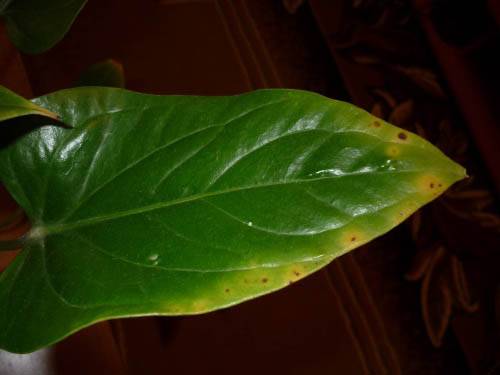

Why is this happening? Sometimes they turn yellow, dry, wilt and fall off, seemingly for no reason. However, there is always a reason. Because, most likely, the wrong care is being carried out.
The reason may be:
- wrong watering regime;
- unsuitable pot;
- wrong location of the flower;
- unsuitable temperature;
- diseases and pests.
Next, each reason for yellowing leaves in anthurium will be discussed in detail.
When is the yellowing of a flower Male happiness is considered normal?
Aging is a natural process inherent in any living organism, anthurium is no exception. Old leaves turn yellow and fall off over time, the intensity with which this happens directly depends on the age of the plant, as a rule, no more than 1-2 leaves per year. If, instead of the fallen off leaves, new ones have grown and the plant as a whole is doing well, the situation does not require any action.
Another worry-free cause for yellow leaves is stress (for example, after moving or replanting). Subject to all the rules of care, anthurium quickly adapts to changes and its foliage will again acquire a bright green color.
Important! If a week after transplanting or moving the plant continues to turn yellow and wilt, then stress is not the only reason. In this case, it is necessary to understand as soon as possible what negatively affects the anthurium and to eliminate this factor.
Anthurium - male flower, description, photo
Representatives of the genus Anthurium live in the tropical rainforests of the Cordillera and Andes mountains. The range of the genus covers North and South America, Colombia, Mexico. The genus includes more than 900 species, of which about 30 varieties are common in culture.
It is interesting! Few know what the non-aesthetic air roots of anthurium are for, so they try to cut them off. This cannot be done, because so exotic will lose the opportunity to extract moisture from the environment.
The appearance of anthuriums, or tails, directly depends on their inherent life form. Some species are represented by lianas, others live on the surface of the ground or in crevices of rocks. Most of the plants are represented by evergreen perennial epiphytes - inhabitants of the upper tier of tropical forests. These species grow directly on the branches of trees, using them as a means of isolating from the soil. So they manage to protect themselves from the encroachments of herbivores.
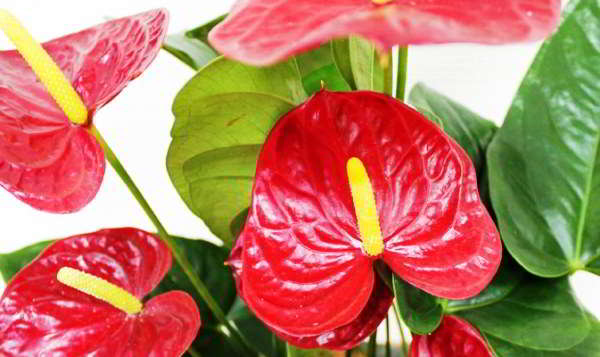

Epiphytes grow aerial roots lined with velamen. The structure of this substance resembles a sponge, which allows the plant to easily get water and food after rain. The peculiarities of growth in natural conditions complicate the care of the epiphyte at home.
The tails have short stems, which have a rounded protrusion at the point of articulation with the leaf. Exotic leaves are whole, have a pronounced central vein. The texture, shape and size of the plate differ depending on the species.
There are species with tiny leaves and giant leaves reaching a length of 120 cm. The most common form of the plate is heart-shaped, but there are also ovoid, lanceolate, pinnate leaves. The surface can be matte, velvety or leathery with a glossy sheen.
Attention! The juice of representatives of the genus Anthurium is toxic. To avoid unpleasant consequences, protect the skin from contact with gloves and keep the flower pot away from pets and babies.
Anthurium is famous not only for its attractive leaves, but also for its luxurious flowers. With due attention of the grower, a luxurious flamingo flower will delight with bright candles almost all year round. The anthurium inflorescence has the shape of an ear, consists of many tiny flowers, tightly adjacent to each other.
Around the cob, the exot forms a bright veil-bracts. White, greenish or red color is inherent in wild-growing individuals. Some varieties are used for cutting, because in the water a bright leathery flower can stand up to 4-6 weeks! Florists note that cutting should be carried out only after the appearance of pollen, otherwise the bud will fade in 3-5 days.
The shape of the inflorescence depends on the species. There are individuals with cobs in the form of neat balls or an even twisted spiral. The color of the inflorescences is different - yellowish, white, cream, green, red. There are individuals with a combined color of the cob.
An amazing exotic exudes various aromas during flowering. The smell can intensify at certain times or change depending on the preferences of the pollinators. When flowering ends, small juicy berries are formed, containing several seeds. The seed ripening process takes a long time. Seeds, however, lose their germination very quickly, do not transmit parental qualities to young individuals.
Seed reproduction at home is practiced extremely rarely, more often succulent bushes are subjected to division or cuttings. On an industrial scale, the main method of reproduction is tissue culture, i.e. cloning of plants.
Advice! If seed reproduction of an individual is not planned at home, it is better to remove the peduncles. Such a measure will prolong the budding period, stimulate the blooming of new flowers.
The species diversity of anthuriums is very wide. In apartments and offices, you can find small bushes 30 cm high with glossy heart-shaped leaves and a bright bedspread. Most likely, this is the kind of Andre or Scherzer that the breeders have worked on. Scientists have expanded the color range of bracts, giving us buds with pink, orange, speckled, purple and chocolate colors.
But there are other worthy representatives of the genus - anthuriums with beautiful velvety foliage covered with a network of silvery veins (majestic, crystal). Lianas with feathery large leaves (many dissected) and unique crops such as the Wendlinger variety with a long spiral ear. The Hooker variety is attractive, forming massive rosettes up to 2.5 m in diameter.
Why do leaf tips dry
If the deciduous edge dries up and becomes thinner at the edges, it is most likely anthracnose, also a fungus that needs to be treated with appropriate drugs. When the tips of the leaves dry and then curl up, this is a greenhouse aphid, which can only be dealt with by using insecticides - Actellik or the well-known Karbofos.
Read also: Kalina - Gordovina - (24 photos): description of black and ordinary, planting and care
In the absence of diseases, if only dry foliage is observed, the container with a flower is removed to a safe distance from the heating. Daily spraying should be included in the flower's diet - regardless of the season.
If the matter, after all, is in anthracnose, anthurium is urgently transplanted into new soil, to which charcoal, pieces of red brick and small parts of forest cones are added. The addition of large particles of natural substances will help to make the soil loose, as a result of which the flow of oxygen to the roots will increase.
Optimal conditions of detention
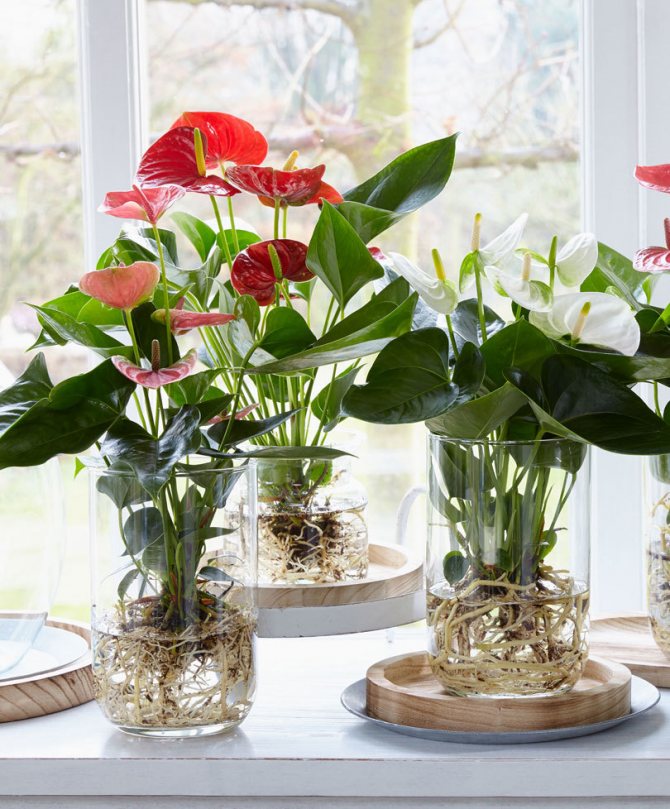

Since anthurium is native to the tropics, it is better to keep it in greenhouses, conservatories and other premises in which conditions are as close as possible to its natural growing environment. You can try to create a beneficial environment for the plant at home, then it will grow without problems, delighting with regular flowering. If the conditions do not meet his requirements, the appearance of the flower will report problems.
Diseases associated with the activation of fungi
The tropical flower is hygrophilous. Trying to maintain the humidity at the proper level, we at the same time create a favorable environment for the development of harmful fungi. They multiply quickly in a warm and humid environment, infect leaves, which are covered with yellow and brown spots, gradually dry out and die off. The most typical fungal formations:
- Septoria - brown formations on foliage, edged with a yellow rim. The leaves die off over time, and after a certain time, if inactive, the plant itself dies.
- Anthracnose - the leaves dry, thin out.
- Peronosporosis - yellowish spots on the surface of the leaf, on the inside of the spores of a grayish tint
- Rust-tinged stains.
One of the main signs of fungal diseases in anthurium is yellowing leaves. What to do if these symptoms appear?
First, reduce humidity. Secondly, treat the soil and the plant itself with a fungicidal preparation. Bordeaux liquid is very effective, especially in the fight against septoria. Thirdly, do not forget about preventive measures and periodically treat the soil with special protective preparations.
Reproduction
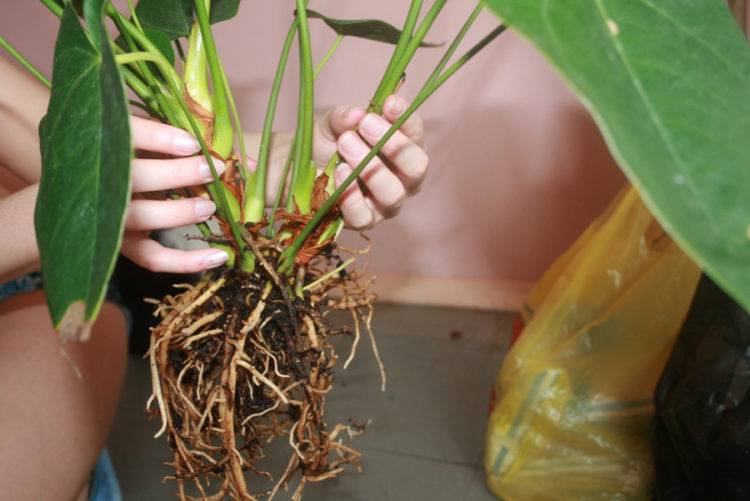

These amazing plants should ideally be propagated with apical cuttings that have few aerial roots. However, this is only suitable for long-stemmed species. Short-stemmed ones reproduce either by seeds or by dividing side shoots.
So, in general, caring for this beautiful plant should not cause problems for its owner. Be attentive and patient - and then the anthurium flower will delight you with its healthy appearance and amazing beauty with flowering.
Aging leaves of anthurium
Why do anthurium leaves dry - this may be due to the natural aging process of the leaves. In this case, signs of drying and yellowing are observed in the immediate vicinity of the soil. The leaf begins to turn yellow from the edge, then along the entire perimeter. With good care, this process does not harm the flower, the old foliage falls off naturally, and new foliage gradually grows in its place.
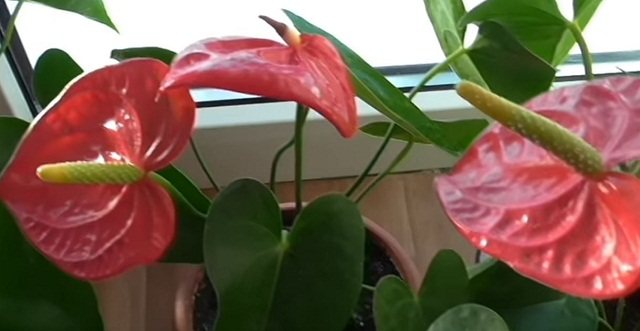

Of course, it is best to cut the old leaves to keep the plant looking attractive, and treat the tool with alcohol. Places of cuts are sprinkled with fine charcoal. Thus, you can help an old plant to renew itself and get the opportunity to rejuvenate, since the appearance of new leaves will not take long.
A timely transplant will also serve as a good stimulus for growth if the root system has grown too much. In advanced cases of old flowers, it can even braid the pot outside, which is fraught with its inevitable trauma during transplantation.
With proper care, anthurium foliage will always look healthy and dense green. When purchasing such a flower, it is important to first familiarize yourself with how to properly take care of it so that there are no special problems in the future.
Anthurium - why the plant dies:
Forum, reviews of florists
Experienced flower growers advise beginners to strictly follow the rules described above, to properly care for the crop. Do not forget to quarantine the purchased flower for 5-7 days to eliminate the risk of infection of other inhabitants of the windowsill.
You should not take up the preparation of the substrate, it is better to buy a ready-made soil mixture. You need to be extremely careful with fertilizers, it is better not to feed the bush a little than to burn its roots. Be sure to work with gloves, because the juice of the tail flower can lead to contact dermatitis.
The appearance of pests
The main pests of anthurium are spider mites, mealybugs, aphids, scale insects, nematodes. These pests feed on the sap of leaves and delicate stalks, which leads to yellowing and leaf fall. At the initial stage of such an invasion, it is necessary to carry out therapeutic water procedures with warm water with a temperature of about 50 degrees Celsius. All leaves and stems must be thoroughly rinsed. And to combat the scabbard, you will need an alcohol-containing liquid preparation, which (with the help of a cotton swab) you need to wipe all the places of its presence on the flower. These procedures can be performed 2-3 times.
If the invasion of pests has already reached a large size, then spraying with warm water will not help. Here it is necessary to act with more stringent methods in the form of special chemical insect control agents (for example, Fitoverm, Neoron, Aktellik and Fufanon).
Improper watering
If anthurium leaves brown spots, dry areas and yellowness appear on the leaves, the problem is most likely in improper watering of the plant. Both lack and excess of moisture have a negative effect on the flower. An excess of moisture leads not only to yellow foliage, but also to root rot, the appearance of mold and fungal diseases.
It should also be borne in mind that if there was water on the leaves of the anthurium (it got after watering, etc.), this can cause brown spots - the sun burns the leaves through the drops of water, like through a lens.
With prolonged exposure to water, necrosis can develop on the leaves - it spreads along the leaf plate, starting from the edges, and gradually spreads throughout the leaf.
What to do: if the problem is an excess of moisture, try to completely dry the soil in the pot. You can even completely replace the entire soil. If you are replanting a plant, check all the roots for rot (it must be carefully cut off).
Dangerous diseases
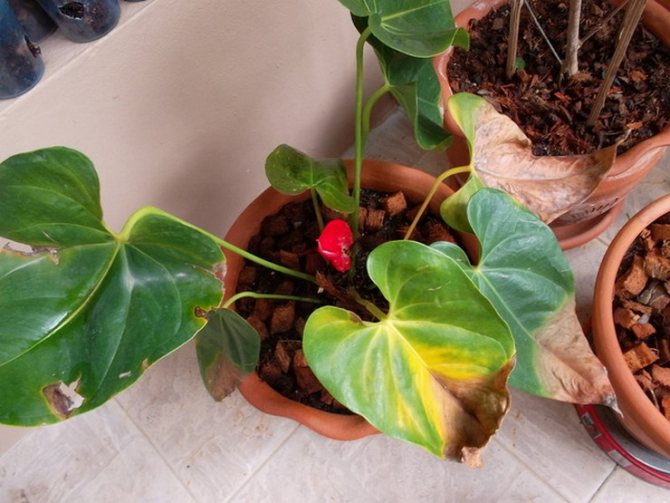

Root rot, leaf chlorosis, septoria and anthracnose are the most common anthurium diseases.
Leaves with a yellow-brown border or spots of the same shade are septoria or anthracnose. Such leaf lesions spread very quickly throughout the entire leaf mass, therefore it is necessary to act very quickly. If only a few leaves are infected with the disease, then the flower can be saved with the help of drugs such as foundationol (0.2% solution) and copper oxychloride (0.5% solution). Having completely removed diseased leaves, it is recommended to treat the entire plant with one of the preparations.
For the prevention of chlorosis, it is recommended to use iron chelate as a top dressing. It is because of the insufficient content of iron and magnesium in the nutrition of the plant that this disease develops. Such fertilization must be applied periodically to prevent an overabundance of these substances.
Rotting of the root part of plants (root rot) appears for several reasons:
- Excess water during irrigation;
- Cold irrigation water;
- Very low air temperature.
Anthurium can be cured only by transplanting it into a new soil mixture and replacing the flower container.
Why anthurium leaves not only turn yellow, but also dry
A combination of yellowing of the leaves with drying out is an unkind sign. The reason may lie both in violation of the conditions of detention, and in a serious illness. If the leaves turned yellow or brown, and then began to dry, you exposed the flower to hypothermia or poured cold water overnight, which made the roots froze. Do not forget to remove the pot from the balcony on time in the fall and do not leave it there in the spring until the end of the frost.
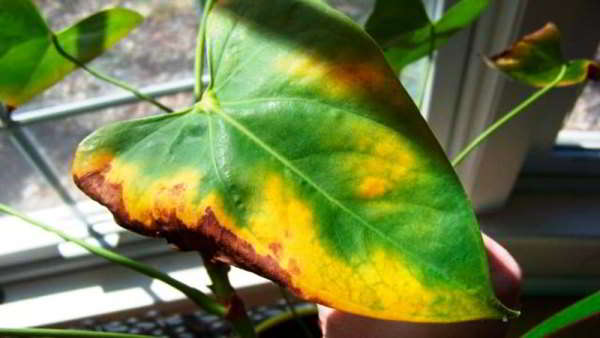

The foliage of the culture will give the same signal in case of sunburn. A tropical guest is very fond of light, but the direct rays of the sun are dangerous for him. Experts recommend placing the pot on the east or west window. If facing south, use a tulle screen or special reflective sheeting.
Drying of foliage along with yellowness may be a consequence of the development of a fungal disease. This feature is typical for fusarium wilting and anthracnose. Fungicides will help fight the disease. Spraying is carried out twice with an interval of 7-10 days.
Remember! If the loss of turgor has joined the drying and yellowing of the deciduous mass, check the substrate. Surely you missed the next watering of your pet, so it began to wither.
Lack or excess nutrition
If the anthurium stops growing abruptly, and its leaves dry up or turn yellow, this can happen due to a lack of nutrients. Lack or absence of phosphorus, potassium, nitrogen, magnesium and other elements will cause the plant to turn brown.
As dressings, special ready-made products are used in a liquid state. Thanks to their effect, the diseased anthurium will restore a healthy and blooming appearance. You need to use these drugs weekly. As soon as the plant regains its former strength, mineral dressing is applied every 14 days.
However, not only a deficit, but also an excess of fertilizers can be the reason why the leaves of the anthurium dry. In this case, the root system must be rinsed in warm water and treated with a disinfectant, and then the plant must be transplanted into a pot with new soil.
Diseases with yellowness and treatment
If the leaves of anthurium turn yellow due to a disease, then you need to identify it and begin the required treatment. So, if we are talking about chlorosis, then you need to spray the plant with iron chelate or algae extract.With this disease, the normal color of the veins remains, and the leaf turns yellow. Also, the anthurium will need more light.
Also, the leaves may turn yellow. due to sunburn
... That is why you cannot overdo it in terms of the sun. A characteristic symptom is yellow or brown spots on the leaves, they themselves then begin to curl and eventually dry out. The best treatment in this case would be to rearrange the flower for a while in a darkened place.
You can not put anthurium in a draft and use very cold water for irrigation. In this case, it may freeze, which will cause small white spots to appear on the leaves. In such cases, they need to be transferred to warmer places.
In addition, yellow leaves can signal the presence of fungi. We will talk about them a little later.
Aging is a natural cause
Anthurium leaves may turn yellow due to old age. This is an inevitable process, so don't worry too much about it. With aging, leaves gradually die off, which are located closer to the ground. Yellowness captures the edges of the sheet plate, and then covers the entire sheet, as a result of which it loses its elasticity and turns brown. If the anthurium is kept in proper conditions, the fall of old leaves is a natural process that does not harm the plant, since new foliage will appear on its top over time.
However, the flower can be helped in a way. To do this, you need to cut off the yellowed old leaves, making the anthurium more attractive and making life easier for it. In order not to infect the plant with an infection, the knife must be treated with alcohol, and the cut area must be sprinkled with charcoal a little. However, do not forget: the leaf cannot be torn off by hand, as this will lead to injury to the stem.
